Cats and Dogs Banned
 Cats and dogs are being banned
in Saudi Arabia and Iran. Religious police authorities, who are
normally tasked with chiding women to cover themselves and ensuring
men attend mosque prayers, are turning to a new target: cats
and dogs. Cats and dogs are being banned
in Saudi Arabia and Iran. Religious police authorities, who are
normally tasked with chiding women to cover themselves and ensuring
men attend mosque prayers, are turning to a new target: cats
and dogs.
The police have issued a decree
banning the sale of the pets, seen as a sign of Western influence.
The prohibition on dogs may
be less of a surprise, since conservative Muslims despise dogs
as unclean. But, the cat befuddled many, since Islamic tradition
holds that the Prophet Mohammad loved cats.
The decree which applies to
the Red Sea port city of Jiddah and the holy city of Mecca, bans
the sale of cats and dogs because "some youths have been
buying them and parading them in public," according to a
memo from the Municipal Affairs Ministry.
Pet ownership is not common
in the Arab world, although dogs are kept for hunting and guarding,
and no other Arab country restricts pet ownership
Dr. Bernard Unti, Senior Policy
Advisor for the Humane Society of the United States reports for
Animal
Radio®.
Citing a core tradition of
concern for animals within Islam, and the universality of the
human-animal bond in all cultures, Humane Society International
(HSI) the global arm of the The Humane Society of the United
States (HSUS) has called upon the Islamic Republic of Iran
to end its crackdown against petkeeping by Iranian citizens.
"We regret reports that police authorities in Iran are
taking steps to suppress petkeeping, and to confiscate dogs from
individual citizens. Islam is one of the strongest religious
traditions when it comes to its prohibitions on cruelty to animals,
and millions of Muslims throughout the world understand their
religious duty to take responsibility for the well-being of all
creatures," wrote Unti in a letter to Mohammad Khazaee,
Permanent Representative of the Islamic Republic of Iran to the
United Nations. (Click here to read the letter)
The presence of petkeeping spans a wide range of cultures across
both space and time. In a trend that parallels those in a number
of other non-western nations, petkeeping is on the rise in Iran,
especially among young people. In China, where authorities have
carried out a series of mass roundups of dogs in recent years,
resistance from an emerging class of petkeepers has been steady
and determined.
In the West as in the East, Unti says, there is confusion about
the teachings of Islam concerning dogs. "Whatever the
prohibition on the keeping of animals in one's house within Islam,
that shouldn't preclude the practice of keeping them in separate
quarters, and providing them with the basic regard and care that
the Quran requires."
 Hear
banned pets coverage on Animal Radio® Hear
banned pets coverage on Animal Radio®
Hear breaking news as it
happens - Animal
Radio® is streaming online 24/7 Listen LIVE Now!
Actress Jane Alexander
 Jane Alexander is riding high
on the release of "Feast of Love," in theaters
now. She plays Esther Stevenson opposite Greg Kinnear. She is
also Honorary Co-Chair for the 2008 Indianapolis Prize; awarded
to an individual who has accomplished a significant achievement
or achievements in the conservation of an animal species or group
of species, resulting in an advance in long-term survivability
and sustainability. Jane Alexander is riding high
on the release of "Feast of Love," in theaters
now. She plays Esther Stevenson opposite Greg Kinnear. She is
also Honorary Co-Chair for the 2008 Indianapolis Prize; awarded
to an individual who has accomplished a significant achievement
or achievements in the conservation of an animal species or group
of species, resulting in an advance in long-term survivability
and sustainability.
 Hear
Jane Alexander on Animal Radio® Hear
Jane Alexander on Animal Radio®
The $12 Million Dollar Dog
(Or $84 Million in Dog Year's Money)
Tralee Pearce, Globe and Mail
 Twelve million dollars will buy
a lot of Milk-Bone. That's the value of a pet trust fund set
up by the late Leona Helmsley to provide for Trouble, her fluffy,
white Maltese, according to court documents made public in New
York. Twelve million dollars will buy
a lot of Milk-Bone. That's the value of a pet trust fund set
up by the late Leona Helmsley to provide for Trouble, her fluffy,
white Maltese, according to court documents made public in New
York.
Ms. Helmsley's brother Alvin
Rosenthal, who received only $10-million, will take care of the
pooch and administer the fund.
Anatomy of a will:
* $12-million to Trouble, Ms.
Helmsley's dog.
* $10-million to Alvin Rosenthal, Ms. Helmsley's brother.
* $5-million each to two grandchildren, David and Walter Panzirer,
as long as they visit their father's grave at least once a year.
* $3-million for Helmsley mausoleum upkeep.
* $100,000 to her chauffeur, Nicholas Celea.
* $0 to grandson Craig Panzirer and granddaughter Meegan Panzirer,
"for reasons which are known to them," Ms. Helmsley
wrote.
Animal Radio®
digs deep, examining pet-trusts for the "not-so-wealthy."
Animal Communicator Joy Turner talks with Trouble. Attorney Adam
Karp advises.
 Hear
Trouble's story on Animal Radio® Hear
Trouble's story on Animal Radio®
Dogs That Know
Alex Tsakiris, Skeptiko
 Many dog owners claim that their
pets anticipate their return, typically by going to wait at a
door, window, driveway, or even at a bus stop (Sheldrake, 1994).
In the early 1990's, Dr. Rupert Sheldrake, a biologist, and former
Fellow of Clare College, Cambridge University, completed a number
of survey studies to find out how many pet owners had observed
seemingly psychic abilities in their pets. Sheldrake's household
surveys found that 46% of dog owners had noticed this ability
in England and 45% in California. Many dog owners claim that their
pets anticipate their return, typically by going to wait at a
door, window, driveway, or even at a bus stop (Sheldrake, 1994).
In the early 1990's, Dr. Rupert Sheldrake, a biologist, and former
Fellow of Clare College, Cambridge University, completed a number
of survey studies to find out how many pet owners had observed
seemingly psychic abilities in their pets. Sheldrake's household
surveys found that 46% of dog owners had noticed this ability
in England and 45% in California.
How You Can Make $1,000
Lets Replicate the Experiment!
The "Dogs that know when their owners are coming home"
experiment is being funded in cooperation with University researchers.
Besides fame and notoriety for special dogs, there is the offer
of a $1,000 prize to any dog owner willing to successfully participate
in the study.
To find out how you can participate, please visit OpenSourceScience.
 Hear
Alex Tsakiris on Animal Radio® Hear
Alex Tsakiris on Animal Radio®
Vladae - The Dog Wizard
 Why is it that children are bitten
the most? It is estimated that there are over 5 million dogs
bites a year, with most of the victims being children. According
to Vladae, a dog sees a child as a puppy. And when that puppy
doesn't respect the older dog - it bites them as a way of correction,
as it would with their own offspring. Why is it that children are bitten
the most? It is estimated that there are over 5 million dogs
bites a year, with most of the victims being children. According
to Vladae, a dog sees a child as a puppy. And when that puppy
doesn't respect the older dog - it bites them as a way of correction,
as it would with their own offspring.
Listen
as Vladae lists the best and worst kid-friendly breeds.
He also explains what he thinks the real problem is
you need to establish human authority over your dog.
Check out Vladae in the new
Michigan Monthly Pet Magazine. He's included a full page of tips
for training your dog on listening and obeying. http://www.Vladae.com
 Hear
Vladae on Animal Radio® Hear
Vladae on Animal Radio®
Is
Your Pet a Blessing?
Diana Guerrero,
Blessing of the Animals
 No matter what your answer--birds,
dogs, cats, and other creatures are invading businesses, churches,
and other religious centers as pet blessings and other ceremonies
are sweeping the nation--the trend has escalated dramatically.
Some people are even shocked that such beastly trends are on
the increase. No matter what your answer--birds,
dogs, cats, and other creatures are invading businesses, churches,
and other religious centers as pet blessings and other ceremonies
are sweeping the nation--the trend has escalated dramatically.
Some people are even shocked that such beastly trends are on
the increase.
St. Francis of Assisi is known
as the patron saint of animals, birds, and the environment, and
it is customary for Catholic churches to hold ceremonies honoring
animals around his feast day of October 4th.
Did you know that pet blessings
pre-date St. Francis?
Most people associate pet blessings with the Catholic tradition
of St. Francis but blessings really began way before and other
traditions celebrate animals BUT the big discovery is that animals
motivate people to cross cultural and religious boundaries.
Do you know what critter ceremonies
are causing the fur to fly?
Some people hate them and some people love them - but the new
trend is to celebrate pets with parties, meow mixers, yappy hours,
memorial services and pet weddings!
Animal Radio®
and Diana Guerrero
have ideas to help you celebrate your friend. http://www.dianalguerrero.com
 Hear
Diana Guerrero on Animal Radio® Hear
Diana Guerrero on Animal Radio®
Jobs
in the Animal World
Animal Precinct's Annemarie Lucas
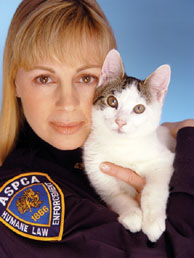 We
speak with Annemarie Lucas, who is a Supervisory Special Investigator
for Humane Law Enforcement (HLE) at the American Society for
the Prevention of Cruelty to Animals (ASPCA). She has received
training by both the New York City Police Department (NYPD) and
the Federal Bureau of Investigation (FBI). Annemarie is also
the star of Animal Precinct. She tells Animal Radio®
how someone interested in this line of work can get started. We
speak with Annemarie Lucas, who is a Supervisory Special Investigator
for Humane Law Enforcement (HLE) at the American Society for
the Prevention of Cruelty to Animals (ASPCA). She has received
training by both the New York City Police Department (NYPD) and
the Federal Bureau of Investigation (FBI). Annemarie is also
the star of Animal Precinct. She tells Animal Radio®
how someone interested in this line of work can get started.
HLE/AC officers inspect
kennels, pet shops, stables, and other places where animals are
kept to make sure that animal welfare regulations are being followed.
HLE/AC officers respond to reports of animal cruelty, investigate,
and if warranted, may make arrests. HLE/AC officers also enforce
licensing laws and rescue trapped animals. For example, there
was a fire in a building in Manhattan and ASPCA HLE officers
went into the building with the help of the fire department and
rescued the animals that were trapped in the building.
Humane Law Enforcement/Animal Control Officer
Starting a Pet-Sitting Business
Jaime Deason had trouble finding good pet care for her own pets.
She also thought that others might have the same problem. As
a result, she decided to open up her own pet-sitting business
and contacted Fetch! Pet Care.
But, pet-sitting isn't for
everyone. Here are six things to be aware of:
1. You're going to get dirty.
Be ready for a lot of exercise in all kinds of weather. In the
summer "I definitely take two showers a day," Jaime
Deason says.
2. You'll need transportation.
Make sure you enjoy spending time in your car. Pet sitter Gabe
Schneider estimates that he spends 20 percent of his time driving
from one assignment to another.
3. You won't have steady hours.
Working from home means you never get to leave your job at the
office. Deason says, "My husband has implemented a no-phone-at-the-dinner-table
rule." But otherwise she encourages her sitters to call
her with problems at any time of the day or night.
And because business naturally
fluctuates, Deason can't guarantee her sitters, who are independent
contractors, a set number of hours.
4. Your vacation time will
be unusual.
Demand for your services is highest on weekends, summers and
holidays.
5. You'll need to be flexible.
Deason recently gave up a weekend trip to take a boarding assignment
when it was discovered at the last minute that an apartment-living
dog who was assigned to another sitter couldn't handle the stairs
in her house.
6. You'll need to be an animal
and people person.
Perhaps the most important thing to remember is that pet-sitting
is a people business as much as an animal one. And as Deason
says, "With pets, like children, everyone has their own
idea of how to raise them." Some people are laid back, some
people are finicky. "You're going to run into all kinds
of idiosyncrasies," Deason says. "Some people like
their dog food mixed by hand. You'll never cease to be surprised."
Who would have thought that
caring for pets could be lucrative? The fact is, over 69% of
U.S. households own one or more pets and the demand for specialized
pet care services outfaces the supply of professionally trained
operators. In 2007, Americans are projected to spend over $41
billion on their pets - double of just a decade ago. By 2009
this number is projected to grow to over $52 billion.
 Hear
Jobs in the Animal World on Animal Radio® Hear
Jobs in the Animal World on Animal Radio®
Is
Feline Hyperthyroidism Caused by Household Products?
Dr. Louise Murray,
ASPCA Bergh Memorial Animal Hospital
 The ASPCA® (The American Society for the
Prevention of Cruelty to Animals®) has recently learned about
a new study conducted by the Environmental Protection Agency
(EPA) that investigated the possible connection between the presence
of polybrominated diphenyl ethers (PBDE)-a flame retardant chemical
added to a wide variety of household products-and an increase
in feline hyperthyroidism. The study-lead by Dr. Janice A. Dye
and published in the journal Environmental Science and Technology
on August 15, 2007-confirmed high levels of PBDEs in some housecats;
however there was not conclusive evidence linking this to the
disorder. The ASPCA® (The American Society for the
Prevention of Cruelty to Animals®) has recently learned about
a new study conducted by the Environmental Protection Agency
(EPA) that investigated the possible connection between the presence
of polybrominated diphenyl ethers (PBDE)-a flame retardant chemical
added to a wide variety of household products-and an increase
in feline hyperthyroidism. The study-lead by Dr. Janice A. Dye
and published in the journal Environmental Science and Technology
on August 15, 2007-confirmed high levels of PBDEs in some housecats;
however there was not conclusive evidence linking this to the
disorder.
The use of PBDEs has been under
scrutiny for several years as a potential health risk for humans,
potentially causing problems in both the nervous and reproductive
systems. The recent attention towards its effects on cats is
fueled in part by concern regarding what these findings may indicate
about potential problems affecting humans in the long run.
What are PBDEs?
PBDE (polybrominated diphenyl ethers) is a common flame retardant
used in the production and manufacturing of a wide variety of
household items, most notably, upholstery, carpets, and mattresses.
In use since the 1970s, products that contain PBDEs have been
found to shed this chemical into house dust, which can then be
inhaled or ingested into the body.
What is feline hyperthyroidism?
"Hyperthyroidism is one of the most common conditions found
in older cats," says Dr. Murray. "It's usually caused
by a benign tumor of one or both thyroid glands, which can lead
to increased levels of thyroid hormone in the body." Symptoms
of hyperthyroidism in cats can include weight loss, rapid heart
rate, vomiting, diarrhea, increased appetite and/or thirst and
increased urination.
Is feline hyperthyroidism fatal?
Dr. Murray clarifies that feline hyperthyroidism, when treated
with the appropriate therapy, is not a fatal disease. "This
is generally an extremely treatable disease, and with certain
treatment methods, can even be cured," she says. "The
disease is mainly fatal in cats who have not received timely
care, resulting in heart disease and eventually heart failure.
"
Do PBDEs cause feline hyperthyroidism?
"Although it is possible that PBDEs may increase the risk
of hyperthyroidism in cats, this disease is a common illness
in senior cats," says Dr. Murray. "Due to better health
care now available to our pets, and the benefits of living inside
the home, cats are living longer, and as a result the increase
in cases of thyroid disease is not unexpected."
How can I keep my pet safe
from such potential PBDE dangers?
To keep you and your pet safe, the ASPCA recommends taking the
following precautions:
- Use a vacuum with a HEPA filter
and change the filter regularly
- Use an air conditioner with
HEPA filter and change the filter regularly
- Cover tears in upholstery
that expose polyurethane foam, particularly if the foam is crumbling
- Cover mattresses with tightly
woven allergen barriers to reduce dust that could carry PBDEs.
Do not remove the mattress label, as it will tell if polyurethane
foam was used.
 Hear
Dr. Murray on Animal Radio® Hear
Dr. Murray on Animal Radio®
Cat
Predicts Death
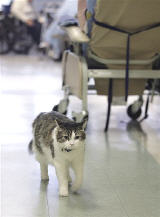 Oscar
the cat, who was adopted as a kitten by the Steere House Nursing
and Rehabilitation Center, seems to be able to predict when patients
there are close to death. Oscar
the cat, who was adopted as a kitten by the Steere House Nursing
and Rehabilitation Center, seems to be able to predict when patients
there are close to death.
When a patient is near death,
Oscar curls up to them during their final time. He has been accurate
in over 25 cases. Now, when the staff see Oscar with a patient,
they call family members to come to their loved ones bedside.
The patients that get a visit
from Oscar are very ill and probably ware not aware of his presence.
However, family members are comforted knowing that their family
member was not alone.
Oscar recently received a wall
plaque publicly commending his "compassionate hospice care."
 Hear
about Oscar on Animal Radio® Hear
about Oscar on Animal Radio®
 Celebrity-Autographed Dog Collars Celebrity-Autographed Dog Collars
Animal
Radio® checks in with 9 year old Kyle Orent.
Kyle's Auction of celebrity-autographed dog collars has raised
upwards of 2 grand...and it isn't slowing down. He found a matching
donor this week.
New to Animal Radio®?
Listen to Kyle's
Journey
Some of the collars that are
up for auction are signed by Donald Trump, Billy Joel, Leslie
Nielsen and Payton Manning to name a few. Hurry and bid for yours, there are a few left!
Not only will you receive a great collar autographed by a celeb,
but also the money goes to a great cause, Canine Companions for Independence. Everyone
wins. Quick-control
Leashes and collars donated by Bamboo.
 Hear
Kyle's Update Animal Radio® Hear
Kyle's Update Animal Radio®
Summer-end New Pet Products Special Live from SuperZoo in Las
Vegas
Sponsored by Canine Caviar
and Austin
Rose, Inc.
  Animal Radio®
counts down the top
25 new pet products from the industry trade show. Our fav's this
year? The Mouse In the House Cat Toy and Ruth Regina's
Wigs For Dogs. See the
newest products. Animal Radio®
counts down the top
25 new pet products from the industry trade show. Our fav's this
year? The Mouse In the House Cat Toy and Ruth Regina's
Wigs For Dogs. See the
newest products.
 Hear
the New Product Special on Animal Radio® Hear
the New Product Special on Animal Radio®
Alzheimer's Found in Cats
Dr. Danielle Gunn-Moore
 Aging cats can develop a feline
form of Alzheimer's disease, a new study reveals. Scientists
at the Universities of Edinburgh, St Andrews, Bristol and California
have identified a key protein which can build up in the nerve
cells of a cat's brain and cause mental deterioration. Aging cats can develop a feline
form of Alzheimer's disease, a new study reveals. Scientists
at the Universities of Edinburgh, St Andrews, Bristol and California
have identified a key protein which can build up in the nerve
cells of a cat's brain and cause mental deterioration.
Dr Danielle Gunn-Moore, at
the University of Edinburgh's Royal (Dick) School of Veterinary
Studies, said: "This newly discovered protein is crucial
to our understanding of the aging process in cats. We've known
for a long time that cats develop dementia, but this study tells
us that the cat's neural system is being compromised in a similar
fashion to that we see in human Alzheimer's sufferers. The gritty
plaques had only hinted that might be the case now we know.
"The shorter life-span
of a cat, compared to humans, allows researchers to more rapidly
assess the effects of diet, high blood pressure, and prescribed
drugs on the course of the disease. However, we also need to
understand more about our geriatric cats for their own benefit,
so we can slow down the degeneration the disease brings and keep
them as happy cats for as long as possible."
"As with humans, the life
expectancy of cats is increasing and with this longer life runs
the greater chance of developing dementia. Recent studies suggest
that 28% of pet cats aged 11-14 years develop at least one old-age
related behavior problem and this increases to more than 50%
for cats over the age of 15."
Experts suggest that good diet,
mental stimulation and companionship can reduce the risk of dementia
in both humans and cats. Dr Gunn Moore explained: "If humans
and their cats live in a poor environment with little company
and stimulation, they are both at higher risk of dementia. However,
if the owner plays with the cat, it is good for both human and
cat. A good diet enriched with antioxidants is also helpful in
warding off dementia, so a cat owner sharing healthy meals like
chicken and fish with their pet will benefit them both."
The findings of the study are
published in a recent edition of the Journal of Feline Medicine.
http://www.fabcats.org/news/alzheimers.php
 Hear
Dr. Danielle Gunn-Moore on Animal Radio® Hear
Dr. Danielle Gunn-Moore on Animal Radio®
Coming Up on Animal Radio®:
 Glenn
Close has had a lengthy career as a versatile actress and
performer. Glenn is remembered for her chilling roles as the
scheming aristocrat Madame de Merteuil in Dangerous Liaisons,
terrorizing puppies as Cruella di Vil in 101 Dalmations
and as the psychotic book editor Alex Forrest in Fatal Attraction.
In her new series, Damages, Glenn brings force and power
as Patty Hewes, a fierce litigator who has a dog killed. Listen
in as Glenn reveals that she is nothing like the characters she
plays, and in fact is a big animal lover! Glenn
Close has had a lengthy career as a versatile actress and
performer. Glenn is remembered for her chilling roles as the
scheming aristocrat Madame de Merteuil in Dangerous Liaisons,
terrorizing puppies as Cruella di Vil in 101 Dalmations
and as the psychotic book editor Alex Forrest in Fatal Attraction.
In her new series, Damages, Glenn brings force and power
as Patty Hewes, a fierce litigator who has a dog killed. Listen
in as Glenn reveals that she is nothing like the characters she
plays, and in fact is a big animal lover!
 Comedian,
writer and actress, Jane Lynch 's breakthrough film role
was as Christy Cummings, the masculine-lesbian personal dog handler
to trophy wife Sheri Ann Cabot (Jennifer Coolidge) in the director
Christopher Guest's 2000 mockumentary Best in Show. Jane
is the host of the 2nd Annual "Race for the Rescues" Animal
Rescue 5K Run/Walk and Adoption Day at the Rose Bowl, Sunday,
October 28th. Animal
Radio® will be broadcasting live! Comedian,
writer and actress, Jane Lynch 's breakthrough film role
was as Christy Cummings, the masculine-lesbian personal dog handler
to trophy wife Sheri Ann Cabot (Jennifer Coolidge) in the director
Christopher Guest's 2000 mockumentary Best in Show. Jane
is the host of the 2nd Annual "Race for the Rescues" Animal
Rescue 5K Run/Walk and Adoption Day at the Rose Bowl, Sunday,
October 28th. Animal
Radio® will be broadcasting live!
 Cesar
Millan, America's most-popular
dog trainer is back for a fourth season of The Dog Whisperer.
Millan has released a new book, "Be the Pack Leader."
Animal
Radio® welcomes him back for his fourth appearance.
Last time, it got intimate. Don't miss him on his favorite radio
show. He gets personal on "breed-bans." Cesar
Millan, America's most-popular
dog trainer is back for a fourth season of The Dog Whisperer.
Millan has released a new book, "Be the Pack Leader."
Animal
Radio® welcomes him back for his fourth appearance.
Last time, it got intimate. Don't miss him on his favorite radio
show. He gets personal on "breed-bans."
 Best-selling author Robert Fulgham's
(Everything I need to know I learned in Kindergarten -
16-million copies) new book begins with a question we've
all asked ourselves: "What on Earth have I done?" Animal Radio® is
proud to have this current-day philosopher as a special guest.
As an ordained minister, he often deals with animal issues, especially
related to grieving and death. Best-selling author Robert Fulgham's
(Everything I need to know I learned in Kindergarten -
16-million copies) new book begins with a question we've
all asked ourselves: "What on Earth have I done?" Animal Radio® is
proud to have this current-day philosopher as a special guest.
As an ordained minister, he often deals with animal issues, especially
related to grieving and death.
|
Animal Radio® made
possible by: Safe-Guard
 Get
ready for spring by protecting your dog and your family
against intestinal worm infections! Did you know that eggs
and larvae that infect dogs can survive in the environment for
months even in extreme winter weather conditions? And that
those same parasites can also infect humans? Why take chances?
Make intestinal deworming an important part of your dog's routine
health care with Safe-Guard® Canine Dewormer a safe
and effective way to eliminate and prevent the major intestinal
worms that can infect dogs all year round. Just sprinkle it on
your dog's food twice a year, for complete peace of mind! Get
ready for spring by protecting your dog and your family
against intestinal worm infections! Did you know that eggs
and larvae that infect dogs can survive in the environment for
months even in extreme winter weather conditions? And that
those same parasites can also infect humans? Why take chances?
Make intestinal deworming an important part of your dog's routine
health care with Safe-Guard® Canine Dewormer a safe
and effective way to eliminate and prevent the major intestinal
worms that can infect dogs all year round. Just sprinkle it on
your dog's food twice a year, for complete peace of mind!
Visit www.Safe-Guard.com for information on treating
and preventing intestinal worms.
|
|
Animal Minute on
Animal
Radio®
with Britt Savage |
GOOD DOG: Dog Performs Heimlich
maneuver
 Little
did Debbie Parkhurst know that when she found a dog in a dumpster
2 years ago, that he would save her life. Little
did Debbie Parkhurst know that when she found a dog in a dumpster
2 years ago, that he would save her life.
Debbie Parkhurst, 45 years
old from Calvert, Maryland, found a Golden Retriever in a dumpster
years ago and took him home and named him Toby. Recently, Debbie
was eating an apple in her home when she got a piece of the apple
stuck in her throat. She immediately tried to remove it by jumping
up and down, with no luck. She then started beating on her chest,
and when Toby saw what was going on, he got involved. He jumped
up; putting his front paws on her shoulders and knocked her down.
He then started jumping up and down on her chest, dislodging
the piece of apple.
While some skeptics believe
Toby thought it was a game, Debbie truly believes that Toby knew
what he was doing and saved her life.
BAD DOG: Dog Burns Down Kitchen
 A pet dog caused $50,000 of damage
when it turned on its owner's cooker and burnt down the kitchen.
Skylar, a three-year-old 'goldendoodle', apparently started a
kitchen fire when she tried to jump on the stove to get leftover
pizza. It happened after her owner Fred Haines left his home
in Naperville, Illinois, to go to work, reports the Chicago Sun-Times. A pet dog caused $50,000 of damage
when it turned on its owner's cooker and burnt down the kitchen.
Skylar, a three-year-old 'goldendoodle', apparently started a
kitchen fire when she tried to jump on the stove to get leftover
pizza. It happened after her owner Fred Haines left his home
in Naperville, Illinois, to go to work, reports the Chicago Sun-Times.
The designer pooch, a cross
between a golden retriever and a poodle, is believed to have
switched on a knob, which ignited the cardboard underneath the
pizza. The flames spread to a nearby plastic cutting board, and
then to the cabinets above the stove, Naperville fire officials
said. Haines, 32, said he had been running five minutes late:
"I didn't do my typical sweep through the kitchen to make
sure Skylar couldn't get at anything," he admitted.
Firefighters broke down a door
after neighbors raised the alarm and rescued the unconscious
Skylar. Paramedics used oxygen to revive her. "Skylar's
fur is white, but when I saw her that day, she was literally
a black dog from the fire's soot and ash," Haines said.
Britt Savage is a regular
Animal
Radio® correspondent as well as an incredibly talented
musician! She can be heard daily on Animal Radio Network.LISTEN TO ANIMAL RADIO NETWORK NOW
Animal
Radio® made possible by: Canine
Caviar
 DOES
YOUR DOG HAVE GINGIVITIS OR ACHY JOINTS? DOES
YOUR DOG HAVE GINGIVITIS OR ACHY JOINTS?
* Cleans Teeth & Gums - Keratin removes tartar & plaque.
* Improves Joint Health - Rich in chondroitin sulfate.
* Perfect for puppies and dogs of all ages!
Fish stix are 100% natural and are an excellent source of chrondroitin
and will clean the pet's teeth better than anything on the market.
Fish
stix compete directly with the bully stix and greenies, but have
more benefits. They are completely digestible and contain no
chemical preservatives, additives, or fillers.
http://www.caninecaviar.com |
|
Veterinary Minute
on Animal Radio®
with Dr. Jim Humphries |
Allergic
Pets and People
 From
springtime through the late fall, many people are subject to
seasonal allergies. But people are not the only ones suffering.
For our dogs and cats, these same seasons can bring intense itching
and discomfort. Yes, it seems our pets can get their own "hay
fever". From
springtime through the late fall, many people are subject to
seasonal allergies. But people are not the only ones suffering.
For our dogs and cats, these same seasons can bring intense itching
and discomfort. Yes, it seems our pets can get their own "hay
fever".
It's a very frustrating and
somewhat common situation. Pet owners by the millions flock to
their veterinarians in the hope of relieving their pet's itchiness.
For many people, the constant chewing, licking, and scratching
can test their love for their pets.
Current estimates show that
about 20 million pets suffer from some sort of skin condition
and many of these are allergies. Allergies are an over-reaction
of the body's immune system to a foreign substance, such as pollen
or flea saliva. For people with allergies, we sneeze and sniffle
as our bodies respond to histamine released by immune cells.
These symptoms are due to the reaction of histamine with receptors
in our nose and upper airways.
Our pets, however, react somewhat
differently. Dogs and cats have many more histamine receptors
in the skin and fewer in the nose. As histamine is released,
the receptors cause an itchy feeling and the pet reacts by scratching
at that site. Scratching can generate more histamine release,
thereby causing more scratching. The constant assault on the
skin by the pet's claws can actually damage the skin, leading
to bacterial infections. Areas of hair loss and oozing sores
known as "hot spots" are very common with allergies.
Fleas are often found to be
the reason for a pet's itchiness. However, the pet who is truly
allergic to fleas will often appear to have no fleas at all!
Why? Because these pets are the ultimate flea catchers, doing
everything in their power to bite or scratch the discomfort of
the flea away. The flea's saliva sets off an allergic reaction
leading to a flurry of chewing and digging at the skin.
Allergies to airborne substances,
such as pollen and mold spores, are another reason for itchiness
in pets. This is known as atopy and affects many pets from springtime
straight through until fall. This condition can be inherited
in certain breeds.
If your pet has signs of allergies
year round and you see little or no improvement with certain
medications, you may have a pet that has food allergies. Contrary
to popular belief, food allergies take time to develop and are
not due to recent diet changes. Most pets who develop food allergies
have been eating the offending food with little problem for years.
Common food allergens can include any major protein or carbohydrate
source in the pet's food.
In some mild cases, the itchiness
can be treated with anti-histamines or even steroids for a short
period of time. However, pet owners need to be aware that allergies
are not a condition that can be cured. The good news though,
is that they can be well-managed with a team effort from the
pet owner and the veterinary team.
Utilizing diagnostic tests
such as blood testing and even skin allergy tests, veterinarians
can often find ways to reduce the pet's discomfort level. In
some cases, your family veterinarian may refer you and your pet
to a veterinary dermatologist. This specialist has many more
diagnostic and treatment resources available to bring relief
to your pet. In all cases, you, the pet owner, are a vital part
of the team. It will be up to you to make sure that all pets
in the household are treated for fleas or that your pet stays
on the recommended hypo-allergenic diet and doesn't sneak other
treats!
Allergies are not only one
of the most frequent reasons for a trip to the veterinarian,
but are also a big reason for pet owners becoming frustrated
with their pet. Working with your veterinary team to identify
what is causing your pet's symptoms will help keep your four-legged
family member right where he needs to be with you! Visit www.MyVNN.com to
see a video of how pet owners deal with their pet's allergies.
Dr. Humphries is a veterinarian
in Colorado Springs and the National News Director for Veterinary News Network. Hear the Veterinary
Minute exclusively on Animal Radio®-LISTEN TO ANIMAL RADIO NETWORK NOW
Animal
Radio® made possible by: URINE
OFF
 Did
you know that Urine Off is the #1 Vet recommended Urine Odor
and Stain Remover. In fact, for the last 3 years THOUSANDS of
Vets nationwide have recommended Urine Off to their clients,
solving their #1 Household problem, unsightly urine odors and
stains. Urine Off's professional strength formula is designed
to remove odors and stains even old ones, by getting down
to the source of the problem and removing it permanently. Endorsed
by many of the leading animal organizations, and sworn on by
our thousands of loyal customers, who after using it always say
the same thing: "Thanks Urine Off, finally something that
works." http://www.UrineOff.com Did
you know that Urine Off is the #1 Vet recommended Urine Odor
and Stain Remover. In fact, for the last 3 years THOUSANDS of
Vets nationwide have recommended Urine Off to their clients,
solving their #1 Household problem, unsightly urine odors and
stains. Urine Off's professional strength formula is designed
to remove odors and stains even old ones, by getting down
to the source of the problem and removing it permanently. Endorsed
by many of the leading animal organizations, and sworn on by
our thousands of loyal customers, who after using it always say
the same thing: "Thanks Urine Off, finally something that
works." http://www.UrineOff.com |
|
 Enter to Win
Enter to Win
UrineOff's "Picture
Yourself In Hollywood" Sweepstakes With Celebrity Pet Photographer,
Christopher Ameruoso!
 Urine-Off,
the number one vet recommended solution to pet odors and stains
has paired up with Chris Ameruoso, Hollywood's #1 celebrity pet
photographer to bring you the "Picture Yourself in Hollywood"
Sweepstakes. The grand prize winner receives an all expense paid
trip to Hollywood for 2 and their PET, plus a photo shoot with
Christopher Ameruoso. Chris has been photographing celebrities
with their pets since 1998, and his work has been featured in
People Magazine, In Style, the New York Times, and countless
others. His work can be seen in his weekly column in In Touch
Magazine titled "Stars and Their Pets". Urine-Off is
the leading veterinarian choice for stain and odor removal, and
is committed to the well-being of pets and their owners. Urine-Off,
the number one vet recommended solution to pet odors and stains
has paired up with Chris Ameruoso, Hollywood's #1 celebrity pet
photographer to bring you the "Picture Yourself in Hollywood"
Sweepstakes. The grand prize winner receives an all expense paid
trip to Hollywood for 2 and their PET, plus a photo shoot with
Christopher Ameruoso. Chris has been photographing celebrities
with their pets since 1998, and his work has been featured in
People Magazine, In Style, the New York Times, and countless
others. His work can be seen in his weekly column in In Touch
Magazine titled "Stars and Their Pets". Urine-Off is
the leading veterinarian choice for stain and odor removal, and
is committed to the well-being of pets and their owners.
Each and every time you make
any purchase at www.urineoff.com between 10/1/2007 and 12/31/2007
you are automatically entered for a chance to win. The more times
you buy, the better your chance of winning. Visit www.urineoff.com
to enter and for official rules.
|
|
Voice of the Animal on Animal Radio®
Rae Ann Kumelos Ph.D. |
Merlin - Master of Animals
 Who would you choose as the most
popular wizard of all time? Gandalf? Obi-Wan? The Wizard of Oz?
Harry? How about the Master of all Wizards - Merlin. Who would you choose as the most
popular wizard of all time? Gandalf? Obi-Wan? The Wizard of Oz?
Harry? How about the Master of all Wizards - Merlin.
Merlin is best known as magician
and indispensable guide to King Arthur. But he is also closely
connected with the world of animals. One theory of the origin
of his name links it to the French word, merle, meaning
blackbird, while another suggests the twelfth-century English
word merilun, the name of a falcon that was used by nobles
for hunting. Both of these names relate to various portraits
of Merlin as the poet-enchanter he has the bold and audacious
manner of blackbird, while as a falcon he is familiar with the
forest.
Merlin is often depicted riding
a stag, accompanied by a wolf or owl. He is also sometimes known
as the Master of Animals with the ability to shapeshift into
any animal form. The Celtic people of Great Britain in the fifth
and sixth centuries, the time frame Merlin and King Arthur were
believed to have lived, considered the arts of talking with animals
and shapeshifting as part of the birthright of the druid, and
the Merlin we know certainly has all the qualities of a druid.
Forged from a single sheet
of silver, the Gundestrup Cauldron, a famous Celtic artifact
of the first century, depicts an antlered man surrounded by animals.
It is Cernunnos, God of Animals, whom many believe to be a druid
or shaman. A version of Cernunnos, also known as the Horned One
or Wild Man due to his antler headdress, occurs in some of the
earliest legends of Merlin. In the Prose Lancelot, this Wild
Man is summoned by Julius Caesar to interpret a vision of Caesar's.
After correctly interpreting the vision, the Wild Man says, "Know
that the great antlered stag that was hunted in Rome, as well
as the Wild Man who interpreted the emperor's dreams, was Merlin."
In this story, Merlin demonstrates the druid's gift of prophecy,
while continuing the Celtic tradition of the stag as an Otherworldly
messenger, bringing power and knowledge from another realm.
Geoffrey of Monmouth first introduced Merlin to the literary
public in the year 1138 with a medieval bestseller about the
history of the Kings of Britain. It is believed that Geoffrey
created his Merlin from the Welsh historical figure of Myrddin,
a confidant and bard to a tribal chieftain who went mad during
battle, escaping to live a life among the animals of the forest.
Over time, Myrddin became known for the gift of communicating
with animals. This motif appears in many of the stories that
surround Merlin, from the twelfth century romances to the present
day depictions of Camelot. Whether he is called upon by Arthur
to communicate with the animals in order to achieve a certain
quest, is asked by Uther Pendragon to divine the meaning of a
fiery dragon-shaped star, or is able to prophecy the meaning
of two dragons living under King Vortigern's tower, Merlin relies
upon his relationship with the animals to ensorcel, sing, or
divine the necessary course of action.
The Celtic scholar, Jean Markale,
writes, that Merlin and St. Francis, although each a proven historical
person, are incarnations of the same myth meaning they both
are figures that represent the great brotherhood between all
living beings-- a mythic brotherhood that lives on today with
our non-historical wizards and their animal familiars Gandalf
and the majestic horse Shadowfax, and Harry with his owl Hedwig.
But it is Merlin to whom all
wizards pay ultimate regard. Like Arthur, the Once and Future
King, it is said that Merlin still lives imprisoned by
a secret spell in an airy castle of glass. Counselor to Kings,
Enchanter of Excalibur, Druid who Knows and Sees All, Master
of the Animals -- Merlin- break the spell and come back to us
now.
Visit us at http://www.voiceoftheanimal.com to hear more
stories and to order CD's of Voice of the Animal programs. Copyright
2007 Voice of the Animal. Rae Ann Kumelos is a regular
Animal Radio® correspondent. She can be heard daily on Animal
Radio Network. LISTEN TO ANIMAL RADIO NETWORK NOW
|
Animal Radio® made
possible by: American Anti-Vivisection
Society
 The
FDA has moved biotech companies one step closer to being able
to put milk and meat from cloned animals on your grocery store
shelves-without labels. Cloning seriously threatens animal welfare,
and you should have the choice to avoid these products! You can
help by calling on the FDA to keep cloned foods off of grocery
store shelves. Learn more at http://www.EndAnimalCloning.org The
FDA has moved biotech companies one step closer to being able
to put milk and meat from cloned animals on your grocery store
shelves-without labels. Cloning seriously threatens animal welfare,
and you should have the choice to avoid these products! You can
help by calling on the FDA to keep cloned foods off of grocery
store shelves. Learn more at http://www.EndAnimalCloning.org
Just because we can clone animals
for food, doesn't mean we should!
|
|
Halloween
Safety Tips for Your Pets
 It's
becoming that time of year again, holiday season is upon us and
the first fun date to kick us off is Halloween. Though the night
can be filled with fun and foolishness, safety for all in your
family is first and foremost. Below you will find Pets911.com's
8 Halloween must do's and don'ts for your furry friends. Make
this Halloween a safe and joyful one for you and your animals!! It's
becoming that time of year again, holiday season is upon us and
the first fun date to kick us off is Halloween. Though the night
can be filled with fun and foolishness, safety for all in your
family is first and foremost. Below you will find Pets911.com's
8 Halloween must do's and don'ts for your furry friends. Make
this Halloween a safe and joyful one for you and your animals!!
1. No chocolate... matter how
cute they look in their costumes! Chocolate is toxic to animals,
in fact according to the AZ Humane Society, a 10 pound dog can
have a fatal reaction to just a few ounces of chocolate! Play
it safe, don't give your animals any treats besides their regular
chews, bones and Charlie Bears!
2. Costumes are the best part of Halloween for most children
and adults, but for our pets, they can be a nightmare. If you
do decide to dress up your pet, please remember these important
pointers:
 Make
sure your pet isn't near an open flame or fireplace; Make
sure your pet isn't near an open flame or fireplace;
- Watch for tripping hazards,
choking hazards, etc...;
- If your dog wears a mask or
head piece, make sure they can see easily and are comfortable,
a frazzled dog can lead to a snippy one; and
- Never leave a dressed up animal
unsupervised!
3. Trick or Treaters equal
open doors keep your pet away from doors and make sure
they are wearing their collars with current tags at all times.
T get your dogs or cats licensed or up to date, please contact
your county or city animal control for licensing fees and information.
4. Watch foil and plastic candy wrappers! Pets could eat them
and choke or get sick.
5. Events like Halloween can be stressful for animals, keep them
inside, and comfortable. Some kids get more adventurous while
wearing a mask and teasing can often occur through gates or fences.
6. Watch open flames around waging tails, a powerful tail can
knock that candle or jack-o-lantern right over.
7. Though lights and mechanical ghouls can be a treat for your
guests, an animal could get quite a shock if they chew on them.
Leave all electrical wires, cords and decorations out of the
reach of your pets.
8. Leave your furry friends at home. Though this night is a great
time for families to trick or treat together, an animal can be
easily startled by costumes and loud noises, so although they
may want to join in, taking them out with you can lead to trouble.

Most importantly, have fun and make sure every member in your
family has a safe and fantastic Halloween!!
Please visit Pets911.com
for our lost and found service, to find an adoptable pet, or
for pet-related information.
Animal
Radio® is a proud partner with Pets911! Hear
about the latest Pets911 activities on-air on Animal Radio®

Thanks for all your entries!
|
Winners of the Summer Giveaway:
Christy Thompson & Jill Spackman
A Special Thanks to:  |
|
LISTEN TO ANIMAL RADIO NETWORK NOW
|
 NETWORK PROGRAMS: NETWORK PROGRAMS:
Animal Radio®
Pet Talk Radio!
Talk
with Your Animals
Veterinary
Minute and Animal
Minute
Voice
of the Animal
and more great programming coming this fall...
Help From A Friend
 Over
the year of reading these articles for Animal Radio®, you
probably have noticed that my friends and I live life differently
than most. Our day-to-day decisions are based on what is mutually
acceptable for our animal kids and ourselves. We appreciate the
input we receive from our animal kids and do our best to fulfill
their wishes. Over
the year of reading these articles for Animal Radio®, you
probably have noticed that my friends and I live life differently
than most. Our day-to-day decisions are based on what is mutually
acceptable for our animal kids and ourselves. We appreciate the
input we receive from our animal kids and do our best to fulfill
their wishes.
I'd like to share an example of this with you. (Martha Music
took my communications classes.)
My friend and coordinator, Martha moved to a new house this summer.
Since she was downsizing, there were decisions on what to pack,
donate, and give to friends and family. She was thoroughly enjoying
the process because she wanted her home to reflect who she is
now. Through the process of packing and unpacking, she sensed
the energy of the item and found an appropriate home for it.
After a while the task became overwhelming, items were stuffed
in boxes even though that was not the original intent of the
unpacking.
To her rescue, came one of my kitties, Venus. Up until this time
Venus has always been a very quiet kitty content to let others
of the family make decisions and choices for things. One day
while Martha was sorting through things, she heard, "I want
to give that to my new baby puppy sister." She asked, "Who
is talking?" She felt and saw a picture of my kitty, Venus.
Venus spent the next few days hovering energetically around Martha
while she unpacked those stuffed boxes. Venus found things for
me, her new baby sister and herself. When Venus was done, Martha
asked her if she had found anything for her brothers. The answer
was no. Having thought Venus was done with her shopping, Martha
started to empty a box filled with tools and odds and ends. She
was startled when she heard, "I found it." Venus wanted
to give a knob in the shape of a lion's head to her brothers.
Martha was surprised that Venus was still energetically around.
After that, Venus sensed that this kind of interaction was becoming
a bit too much for Martha and left her alone. Martha was very
appreciative of Venus' help up to that point.
Animals have many interests when we allow them to participate
in all aspects of life with us. For example:
When I was re-arranging furniture in my house, Venus told me
that I should put a standing lamp right by a chair. She suggested
that I ask Martha if she had a standing lamp that needed a home.
Venus has gotten quite used to Martha rehoming things and loves
to "shop" at Martha's house. Venus did not want to
pester Martha for a lamp by going into her head and asking her
for a lamp. That's why she wanted me to ask. For now, Martha
does not have a standing lamp in need of a home. When there is
one, it will go to live in the spot Venus suggested. Or, if I'm
shopping somewhere and she sees a lamp she likes, we will get
that one and bring it home for that spot.
Animals love to shop with their humans. As with Martha and myself,
they are connected in your mind so they can see, hear, smell,
and have any other sense we have through us. So they get to see,
feel, taste, etc. what we are doing. Many of my animal kids go
shopping with me. My human daughter's dogs and cats love to go
grocery shopping with her to let her know what they want to eat
for the week. When I go to restaurants, everybody gets to tell
me what they would like to eat because I always bring something
home for them.
My kids love to shop for me. Braveheart, Ala, and Dreamweaver
have all gone to my human daughter, Cyndi, and told her what
to buy for me for presents for birthdays, Christmas and especially
Mother's Days. Braveheart loves to buy jewelry for me (I could
use a human guy like that!).
Now my birthday is approaching soon, and Venus wants to get into
the act. She wanted to give me a birthday gift. (The first one
she has chosen.) So guess whom she asked to help her. That's
right, Martha! And, guess what "store" she sent to
with Martha. You guessed, Martha's house. Venus found a lavender,
green and white crotchet doily in a closet in Martha's house.
She wanted that for me because those are my favorite colors and
it felt so soft. Then, of course, Venus wanted a card. They found
some words on a card that Venus liked so she asked Martha to
put them on "her" card. Martha wrote on a blank note
card of Venus's choosing. My birthday is the day before our new
baby girl comes home. Venus asked Martha to give me the gift
this week at our house so her gift was not overshadowed by the
homecoming and Venus could be with me when I opened it.
After I opened the card and gift, Venus explained to me about
how she was feeling with the new addition to our family. We had
a chat about the new puppy girl being a baby as well as our baby
puppy who just passed. It is very interesting how this gift helped
Venus to open up to talk with me about her feelings. She is very
contented that Martha was able to help her. And very pleased
to have a friend that can hear her and is willing to help her
with these kinds of things.
When you look at your animal kids while they are sleeping or
resting, you may think that is all they are doing. Perhaps that
is not all they are doing. Energetically, they could be shopping,
visiting with someone, etc. They have the ability to do more
than just keep us company, eat and sleep. I think if Venus was
a human, she would be going to garage sales every Saturday with
her friend, Martha.
So, the next time you would like some input, another opinion,
or just want to share anything in your life with someone you
love and loves you, share with your animal kids. You'll have
a ball and they'll love it!
Until next time, I'm Joy reminding you, you can never love your
animal companions too much. You can only love them, hopefully,
enough.
If you would like to
schedule a private session with Joy, call 425-867-1779 or go
to www.TalkWithYourAnimals.com.
If you are interested in being a caller on Talk with your Animals,
please email Martha@AnimalRadio.com
to make arrangements. Joy Turner is a regular Animal Radio®
correspondent. She can be heard daily on Animal Radio Network.
LISTEN TO ANIMAL RADIO NETWORK NOW
Animal
Radio® is made possible by:
GET SERiOUS!
 - Extracts stains
& odors COMPLETELY
-in only 3 minutes! - Extracts the urine &
the pheromone -so pets aren't attracted back to re-mark! - Extracts stains
& odors COMPLETELY
-in only 3 minutes! - Extracts the urine &
the pheromone -so pets aren't attracted back to re-mark!
- Never leaves any "yellowing" behind (like
most enzyme-based cleaners) and even removes old locked-on
"yellowing" - left behind by other cleaners!
-1 bottle of GET SERiOUS! cleans as much
as 2 bottles of the competition because you only use 1/2 as much
as the others! - $AViNGS ! $AViNGS
! $AViNGS !
http://www.GetSeriousProducts.com |
|
 Email
your events to: root@AnimalRadio.com Email
your events to: root@AnimalRadio.com
 2ND
ANNUAL "RACE FOR THE RESCUES" 2ND
ANNUAL "RACE FOR THE RESCUES"
Animal Rescue 5K Run/Walk and Adoption Day
THE ROSE BOWL, SUNDAY OCTOBER, 28, 2007
Event to Also Include a Celebrity
Art Auction, Pet Halloween Fashion Show & Adoption Event,
Pet Psychic and More
Actress Jane Lynch Returns
as Host

Animal
Radio® broadcasts Live!
The date for the premiere fundraising
event for the Los Angeles animal-loving community has been set.
The 2nd Annual "Race for the Rescues" 5K Run/Walk at
The Rose Bowl in Pasadena will be held this year on October 28th.
The event will benefit non-profit animal rescue organization
The Rescue Train, as well as Best Friends Animal Society, Kitten
Rescue, Animal Alliance, A Dog's Life Rescue, Four-Legged Friends
Foundation, The Lange Foundation, and Molly's Mutts & Meows.
Each year these groups care for and find homes for almost 1,500
abandoned dogs and cats annually. Celebrity host Jane Lynch (THE
40 YEAR-OLD VIRGIN, BEST IN SHOW) will be returning to emcee
the event again this year and PETCO, Natural Balance, Animal
Specialty Group, and Eye Care for Animals have already signed
up as sponsors.
"What many animal lovers
don't know is that here in the City of Angels, hundreds of dogs
and cats are euthanized each week in our city shelters,"
explains Lisa Young, Director of the Rescue Train. "It is
our mission to bring the community together with the common goal
to eliminate this suffering through hands-on rescue, education
and awareness." Last year's inaugural event, the only one
of its kind which brings so many groups together for this common
cause, had hundreds of participants and raised $63,000. This
year's turnout promises to be much larger, bringing together
Girl & Boy Scout troops, school classes, corporate teams,
families, and other groups and individuals for a day of
fun and fundraising for our furry friends!
In addition to the 5K run and
walk, Race for the Rescues will also feature:
- Walk of Paws - A celebrity art auction featuring
one-of-a-kind works created by celebrities and their pets. (Past
participants include famous animal lovers Jessica Alba, Drew
Barrymore, Jim Belushi, Courtney Cox, Paula Abdul, Jennifer Aniston,
Charlize Theron, Carmen Electra, Famke Janssen, Amanda Peet,
Lionel Richie and NBA legend Bill Walton.)
- 1 Mile non-competitive
Kids Race.
- Pet Halloween Adoption
Event & Fashion Show
- After showing off their Halloween best, these "spooktacular"
pets from the Pasadena Humane Society/SPCA and Los Angeles Animal
Services will available for adoption!
- A silent auction featuring such items as tickets to
TV show tapings, specialty pet products and services, spa packages,
portraits, photography, jewelry, celebrity memorabilia, gift
baskets, gift certificates for dining, travel and adventure experiences,
and much more.
- Kids' Costume Contest,
Drawing Class by former Disney animator, Pet Psychic, Dog Training
Demonstration, fun prizes and more!
For full details on Race
for the Rescues and information on The Rescue Train, please
go to www.racefortherescues.org
or www.rescuetrain.org
Alley Cat Allies' National Cat Advocacy
Seminar
 October 12 & 13 October 12 & 13
Washington, D.C.
Join Alley Cat Allies, the
nationally recognized experts on improving the lives of outdoor
cats, in our nation's capital. Learn how you can unite and mobilize
to make nonlethal policies and Trap-Neuter-Return (TNR) the norm.
Topics include best methods of feral cat care, how the law supports
our goals and reforming animal control policy. Presenters are
Becky Robinson and Wendy Anderson of Alley Cat Allies, Dr. Christine
Wilford of Seattle's Feral Cat Spay/Neuter Project, and Dawn
Kua of Singapore's Cat Welfare Society.
CONTACT: For Alley Cat Allies
Francie Israeli
(202) 773-8400
fisraeli@johnadams.com
DOG-O-WEEN
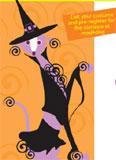 Sunday, October 27, 2007 Sunday, October 27, 2007
4:30pm to 6:30pm
At Mod-Dog Spa & Boutique
2200 Glades Road
Boca Raton, FL
You,re invited to the first DOG-O-WEEN party to benefit getalifepetrescue.com South Florida pet rescue
and rehabilitation, Inc.
There will be a Doggy Costume contest, photos, raffles, treats
for people and dogs, plus local celeb judges and more! Donation
of $10 for costume contest registration. Costumes and Pre-registration
available at Mod-Dog.
Grand prize will be a weekend
stay with your dog at the Circa 39 hotel in Miami Beach FL
Questions - call - 561-338-8883
Hemopet/Pet Life-Line
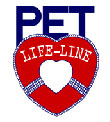 Second Annual Walk-A-Pet For Life
dog Walk Second Annual Walk-A-Pet For Life
dog Walk
Sunday, October 14, 2006
Huntington Beach, CA
Hemopet/Pet Life-Line will
hold its Second Annual "Walk-A-Pet For Life" dog walk
to benefit the Center for Greyhound Rescue and Pet Animal Recovery,
the nation's first non-profit alternative medicine rehabilitation
center for restoring the health of pets.
Hemopet/Pet Life-Line, the
nation's largest animal blood bank, is raising funds for the
nation's first center focused on restoring health for dogs, cats
and other pets with special needs and during recovery. This campaign
is for a permanent two-acre, environmentally friendly, pet rehabilitation
facility in Garden Grove. The new Center will also serve as the
permanent home for Hemopet's unique greyhound rescue-donor-adoption
program and related community service activities. Upon completion,
this new project will feature unique group apartment-style units
for the rescued greyhounds with outdoor exercise yards and playgrounds.
The new greyhound village suite concept is also intended to create
a favorable setting for prospective adopters to view and connect
with the greyhounds.
CONTACT: Kelley Taylor at (714) 891-2022, ext. 15
Jim
Goyjer at (310) 207-1524
 The
Ray of Hope Humane Society The
Ray of Hope Humane Society
Hawthorne, NV 89415
7:00am 9:00am Every Day
775-945-2555
We Need Your Help Over
50 Cats Looking For Homes. The Ray of Hope Humane Society is
located in Hawthorne, NV. We are open from 7:00 am to 9:00 pm
every day of the week.
This year we had 14 kittens and 4 mother cats come in the mother
cats were all very pregnant. Within two days of having these
pregnant cats we had two more litters adding 10 more kittens
to the bunch. We have been in operation, and became a 501(c)(3)
non-profit organization, in 2006. We currently have approximately
50 cats that are in need of homes. Most of these cats and kittens
are up on PetFinder.com.
Animal
Radio® made possible by: SIMPLE
SOLUTION NATURAL
 Earth conscious consumers now have an eco-friendly
choice in pet care. The Natural line of products by Simple Solution
is completely, 100% all-natural. The Biodegradable Training Pads,
used by many pet owners as an indoor potty, are 100% biodegradable
even by California's standards. They'll biodegrade faster than
an orange peel! The line also offers an all natural Pet Stain
and Odor Remover that's a great alternative to harsh chemicals
found in traditional household cleaners. Simple Solution®
Natural Pet Bathing Shampoo cleans and conditions with all natural
ingredients including, plant-based mild cleansers, Aloe Vera,
Vitamin E and Pro Vitamin B-5. Simple Solution Natural is based
on a way of life! Find Simple Solution at Petco, PetSmart or
your local pet retailer. http://www.simplesolution.com Earth conscious consumers now have an eco-friendly
choice in pet care. The Natural line of products by Simple Solution
is completely, 100% all-natural. The Biodegradable Training Pads,
used by many pet owners as an indoor potty, are 100% biodegradable
even by California's standards. They'll biodegrade faster than
an orange peel! The line also offers an all natural Pet Stain
and Odor Remover that's a great alternative to harsh chemicals
found in traditional household cleaners. Simple Solution®
Natural Pet Bathing Shampoo cleans and conditions with all natural
ingredients including, plant-based mild cleansers, Aloe Vera,
Vitamin E and Pro Vitamin B-5. Simple Solution Natural is based
on a way of life! Find Simple Solution at Petco, PetSmart or
your local pet retailer. http://www.simplesolution.com |
|
| ANIMAL
RADIO®
PRODUCT REVIEWS for
October |
|
 Poop-Freeze Poop-Freeze
 (rated 1 out of 5 paws) (rated 1 out of 5 paws)
POOP-FREEZE™ is a specially formulated aerosol freeze spray
that, upon contact, forms a frosty film on dog poop (or cat poop)
to harden the surface for easy pick-up. Or, that is was it is
supposed to do!
When I sprayed it on cat vomit,
the vomit ended up spraying all over the walls and I had a bigger
mess to clean up. I then tried it again, and ended up with a
big mess and an empty can after 3 uses. I wondered if this was
a practical joke. I immediately looked around for cameras catching
the moment the poo hit the proverbial fan...and the wall, and
the TV, and my husbands urn.
While I like the concept (it reminds me of the "Vapoorizer"
from the movie Envy) they need to go back to the drawing
board on this one!
http://www.Poop-Freeze.com
 Deluxe
Fresh Flow Pet Fountain from Petmate Deluxe
Fresh Flow Pet Fountain from Petmate
    (rated 4 out of 5 paws) (rated 4 out of 5 paws)
Even though our pets need plenty
of fresh water, it is always a problem to fully hydrate them.
Basically, you can lead an animal to water, but you can't make
them drink!
Most of us have either had,
or have heard, of an animal that will only drink from your bathroom
or kitchen faucet. And this is usually when you are using it,
trying to do dishes or brushing your teeth. But, it is inconvenient
to stand there until they are done or a waste to leave the water
running.
Why do they do this? Because
animals like cool and oxygenated water. With the Deluxe Fresh
Flow Pet Fountain we were able to have a stream of fresh flowing,
cool and oxygenated water all of the time, with no waste. The
water actually recycles itself and there is even a replaceable
filter to keep the water clean. You can also attach a reservoir
of additional water so you don't have to refill it that often.
We like the new sleek design
and the cats like the trickling water. Just fill it and watch the animals flock to it
and get that sink back to yourself!
Petmate
Send products for review
on-air and in this newsletter to: Animal Radio® Network Product Reviews, 233
East 330 North, Kanab, Utah 84741. Products may not be returned.
|
| Rover, Get Off Her Leg! with
Darlene Arden |

ASK
"THE DOG EXPERT"
- by Darlene Arden, Certified Animal Behavior Consultant
Q. Dear Darlene Arden,
My husband and I got an adorable puppy from the shelter. He's
now four months old and has been fine up until now but we're
having a problem and hope that you can help us. Whenever we play
with him he bites our fingers with his sharp little teeth! We
don't want to hit him, of course, but we don't know why he's
doing this or how to stop it. HELP!!! Please
Sincerely, Inez
A. Dear Inez,
First I want to congratulate you on your shelter puppy. Adding
a new four-legged family member to your house is exciting and
exhausting so much work and yet it pays off in the end
with a wonderful companion. Your puppy is teething. Did the shelter
tell you how old he was when he was taken away from his mother
and littermates? If he was together with them until just before
you adopted him, then he has learned basic bite inhibition from
them. No human can teach that as well. Even with good bite inhibition
you don't ever want to let him bite your hands, not even playfully.
Always yelp like his littermates would and then replace your
fingers with a safe toy and tell him how good he is when he starts
to play with the toy. Have several toys available from which
he can select one that suits his needs at the moment. Sometimes
he'll want to bite on something harder or softer to relieve the
pain and itchiness of his adult teeth coming in. Be sure that
you play safe games with him, do some clicker training every
day and have fun!
"Ask the Dog Expert"
is a regular column by Darlene Arden. This month's column features
information found in her book, "The Angell Memorial Animal
Hospital Book of Wellness and Preventive Care for Dogs,"
(McGraw-Hill), which helps you, in concert with your veterinarian,
design a wellness program based on your dog, your lifestyle and
the place where you live, and "Small Dogs, Big Hearts,"
(Howell Book House), and the newly released, "Rover, Get
Off Her Leg!" Further information may also be found on her
website: www.darlenearden.com.
Copyright 2007 by Darlene Arden. All Rights Reserved.
|
Animal Radio® made
possible by: FIDO FRIENDLY MAGAZINE
 Fido
Friendly magazine lists accommodations where you can stay with
your dog while traveling in the United States and Canada. Each
quarter, our editorial includes hotel, city and state reviews. Fido
Friendly magazine lists accommodations where you can stay with
your dog while traveling in the United States and Canada. Each
quarter, our editorial includes hotel, city and state reviews.
http://www.FidoFriendly.com
Don't miss Fido Friendly
Travel Talk exclusively on Animal Radio®
|
|
| ASK THE BIRD FOLKS with
Mike O'Connor |
Dear Bird Folks,
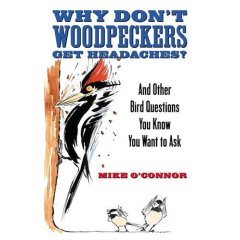 How
often do hawks need to eat? I know that they eat a variety of
prey, but some prey is larger than others. Is a single mouse
going to keep a hawk satisfied for an entire day or will it need
to continue hunting? And what if, instead of a mouse, the hawk
catches a squirrel? Will that keep it full for an entire day
or maybe two? If a meal is large enough, can a hawk go more than
a day without hunting?- Ann, Wakefield, MA How
often do hawks need to eat? I know that they eat a variety of
prey, but some prey is larger than others. Is a single mouse
going to keep a hawk satisfied for an entire day or will it need
to continue hunting? And what if, instead of a mouse, the hawk
catches a squirrel? Will that keep it full for an entire day
or maybe two? If a meal is large enough, can a hawk go more than
a day without hunting?- Ann, Wakefield, MA
I'm wondering, Ann,
I'm wondering why you asked
this question. Are you trying to win some kind of weird bar bet
about hawks' dietary habits? Did someone wager that a hawk could
go for a month on a single squirrel? Or perhaps you are starting
a specialized Weight Watchers group just for raptors. Let's see,
eating a mouse counts as two points, five points for a chipmunk,
and a whopping twenty-seven points for eating an entire jackalope
at one sitting. But who hasn't done that?
Well, whatever the reason for
your question, I'm glad you asked it. Many people don't realize
that birds really do get full. The feeder birds we see chowing
their brains out at 8:00 AM probably won't be the same birds
we see at two hours later 10:00. The early birds fly off to some
protected area to digest and gossip, while a new group of similar-looking,
but different birds, hit the feeder.
 For
small birds, with their high metabolism, resting time is short.
Their tiny bodies don't allow them room to store much food and
they must get back to eating fairly quickly. This is good news
for people who enjoy watching birds at their feeder and even
better news for people like me who sell birdseed. And yes, Ann,
I know you asked about hawks. I promise I'll get to that next.
But since nobody has asked about feeding birds for a while I
wanted to slip that in. I have mortgage payments, you know. For
small birds, with their high metabolism, resting time is short.
Their tiny bodies don't allow them room to store much food and
they must get back to eating fairly quickly. This is good news
for people who enjoy watching birds at their feeder and even
better news for people like me who sell birdseed. And yes, Ann,
I know you asked about hawks. I promise I'll get to that next.
But since nobody has asked about feeding birds for a while I
wanted to slip that in. I have mortgage payments, you know.
For the most part, raptors
don't need to eat as often as the smaller birds do. As you suggested
in your question, one good meal may be enough for an entire day,
or even longer. Also, as you noted, hawks eat a huge assortment
of prey. Red-tailed Hawks can make a nice lunch out of: worms,
crickets, snakes, lizards, bats, birds, mice, squirrels or rabbits.
(I know you didn't mention any particular hawk, Ann, but I've
decided you were thinking about red-tails, since they are so
common. Plus, they are one of the few hawks I actually know a
little about.)
Obviously, there is more meat
on a squirrel than there is on a mouse. A hawk has to catch and
eat several mice if it wants to be full. The exact amount of
food a hawk needs to make it through the day depends on the time
of year and the weather conditions. In order to survive the frigid
northern winters, hawks must generate additional body heat. More
heat means more food. Their food consumption drops during the
summer, which is good news for the hawks since they like to look
fit and trim for the beach. However, the good news doesn't last
long. Once the baby hawks start hatching, the adults shift their
hunting skills into high gear, which means just about every small
creature in the area had better have its life insurance policy
paid up.
During the breeding season,
if a parent hawk catches a rabbit, or some other large prey,
it simply shares the catch with the family. However, after the
fledglings have moved away an adult hawk will have no one to
share a freshly caught rabbit. How sad. Not wanting to waste
the delicious bunny the bird will eat as much as it can until
its stomach is filled and there's no more room. This is when
the hawk switches to plan B. Many birds hide or cache extra food
for later, when the midnight munchies strike. But red-tails usually
don't hide surplus food. Instead, they stuff extra food into
their crop. The crop is a weird little storage room that's just
off the esophagus, between the mouth and stomach. It's like having
a built-in doggie bag. Extra food is swallowed and stored in
the crop until the stomach is able to make room for it. Between
the stomach and the crop, a hawk may indeed eat enough food at
one sitting to keep itself satisfied for several days.
This begs the question: If
a hawk isn't hunting, what does it do with its time? It probably
does what we do when we have extra time - nothing. When birds
aren't feeding, roosting, mating or migrating, they do what is
referred to as "loafing." You probably don't need a
definition of loafing, Ann, especially if you've seen any of
my employees, but bird loafing is much like our loafing. They
basically rest, digest their food, do a bit of preening and wonder
why the kids don't call. See, just like us.
Besides being a frequent
guest on Animal Radio®
- Mike O'Connor is the
owner of the Bird Watcher's General Store on Cape Cod, which
opened in 1983 as one of the first stores in the United States
dedicated solely to birding. His column, Ask the Bird Folks,
appears weekly in The Cape Codder, The Register, The Harwich
Oracle, and The Upper Cape Codder newspapers, and his writing
was included in the Best American Science and Nature Writing
2004. Copyright 2007 by Mike O'Connor. All Rights Reserved. http://www.BirdWatchersGeneralStore.com
|
 Have you heard Animal Radio®
Network Lately? Have you heard Animal Radio®
Network Lately?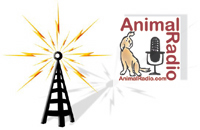
So many ways to listen!
Website: http://AnimalRadio.com
Toll-Free Studio Line is: 1.866.405.8405
|
|
| For
Pet's Sake with Karen
Lee Stevens |
Look
Who's Talking
 Humans may have invented gobs of gadgets
to communicate better with one another (think cell phones, email,
and text messaging), but we still haven't figured out how to
talk to the animals, or have we? Humans may have invented gobs of gadgets
to communicate better with one another (think cell phones, email,
and text messaging), but we still haven't figured out how to
talk to the animals, or have we?
Let's go back thirty years
to a time when Irene Pepperberg, Ph.D., first began studying
the intelligence and reasoning abilities of the African Grey
parrot. After completing her doctoral thesis in theoretical chemistry
at Harvard University, Pepperberg acquired a 1-year-old African
Gray that she named him Alex (an acronym for Avian Learning EXperiment).
Together, Pepperberg and her protégé shattered
the myth that birds are, well, bird brains.
Over the years, Alex developed
a vocabulary of 100 words and demonstrated an ability to count
and recognize dozens of different shapes and colors. He showed
the emotional equivalent of a 2-year-old child and the intellect
of a 5-year-old.
Alex's gift of gab and his
amazing ability to understand human language became the subject
of many scientific journals and numerous television programs,
including PBS's "Nature" series and an episode of "Scientific
American Frontiers" with actor Alan Alda. Through his interactions
with Pepperberg, Alex helped define the bond between humans and
animals and showed us that these brainy birds are capable of
much more than simply mimicking sounds; they excel at cognition
and communication as well.
Last month, Alex, 31, died
suddenly and Dr. Pepperberg and the entire avian community mourn
the plucky parrot's passing. On the Alex Foundation Home Page
(www.alexfoundation.org),
a heartfelt note reads: "Please bear with us as we move
through this difficult time of grief and regain our composure.
We have received thousands of emails and continue to go through
them. The support you have shown us is overwhelming and we are
forever grateful."
We're all Kookoo for Koko.
Speaking of talking animals,
do you remember Koko, the gorilla who can "speak" in
American Sign Language? In 1972, Penny Patterson, a young graduate
student in developmental psychology at Stanford University, volunteered
to teach sign language to a 1-year-old female gorilla named Koko.
Within two weeks of beginning her experiment, Patterson had taught
Koko the signs for food, drink, and more. Today, Koko, with an
IQ of about 90, can sign more than 1,000 words, understand 2,000
spoken words, and can initiate conversation and ask questions.
She's also a pretty darn good artist, as portrayed in the original
watercolors displayed on her Web site www.koko.org.
 Koko's intelligence and her ability
to express empathy and deep emotion have forever changed our
perception of gorillas and how we relate to them. Who can forget
the touching images of Koko cuddling her first kitten, "All
Ball" in the January 1985 issue of "National Geographic"
magazine? Not long after the photos were published, All Ball
was tragically killed by a car and Koko's wrenching sobs and
her distraught sign, "Koko Sad," still haunt us today. Koko's intelligence and her ability
to express empathy and deep emotion have forever changed our
perception of gorillas and how we relate to them. Who can forget
the touching images of Koko cuddling her first kitten, "All
Ball" in the January 1985 issue of "National Geographic"
magazine? Not long after the photos were published, All Ball
was tragically killed by a car and Koko's wrenching sobs and
her distraught sign, "Koko Sad," still haunt us today.
Not only is Koko the world's
most famous gorilla, she is also an ambassador for her species.
As part of the Gorilla Foundation, Patterson and Koko are working
to save the species from extinction. This inevitable outcome
could occur in the next few decades if the gorilla's natural
habitat-the forests of Africa-are not kept from being destroyed
and poachers continue to hunt the gorilla for "bushmeat."
The Foundation, currently located
near Santa Cruz, California, is raising funds to construct a
gorilla preserve on west Maui, Hawaii. The 70-acre sanctuary-provided
by the Maui Land and Pineapple Company-will allow Koko, her mate,
Ndume, and many other gorillas to live in a more natural environment
and afford Koko the chance to have children and teach sign language
to the next generation. To learn more about the preserve and
how you can help, visit www.gorilla.org.
As Koko says: "Time Hurry Go!"
Alex and Koko have proven that
animals have much to teach us about compassion, communication,
and conservation. Isn't it time we started paying attention?
What are you and your animals
talking about? Let Karen (Founder and President of All For Animals, Inc.) know by sending her
an email at karenleestevens@cox.net.
| ASK THE CAT COACH with
Marilyn Krieger |
My Cat Plays Too Rough
Dear Cat Coach,
 I have a 5 month old kitten named
Ninja. We love Ninja to pieces, but she has one annoying habit
that we're worried about. Ninja bites hard when we play with
her. I admit we probably play a little rough with her. Since
we've gotten her, she's loved being rolled on her back and tickled.
We've noticed that as she gets older her bites are getting more
painful, to the point of almost breaking our skins. The other
annoying habit she's recently developed is that she sometimes
attacks our feet at night while we are sleeping. I have a 5 month old kitten named
Ninja. We love Ninja to pieces, but she has one annoying habit
that we're worried about. Ninja bites hard when we play with
her. I admit we probably play a little rough with her. Since
we've gotten her, she's loved being rolled on her back and tickled.
We've noticed that as she gets older her bites are getting more
painful, to the point of almost breaking our skins. The other
annoying habit she's recently developed is that she sometimes
attacks our feet at night while we are sleeping.
From Ouch!
Dear Ouch!
Ninja thinks it's OK to bite you because you've encouraged the
behavior by the way you play with her. Tempting as it is to tickle
and rub that little Ninja stomach, try to refrain from using
your hands when playing with her and please stop roughhousing
with her. Playing with hands and roughhousing with a cat sends
the message that is OK to play rough and to bite. Additionally,
a cat will think it's OK to attack feet and hands during the
night or other times when you are not prepared to engage her
in play.
Instead of using your hands,
use a fishing pole toy when playing with Ninja. Imitate the hunt.
Pretend the object on the end of the toy is a wounded animal,
causing it to scurry, change directions and speed, going under
sofas, etc. The goal is to get little Ninja very involved in
playing with the toy. When you are ready to stop playing don't
abruptly stop the action. Instead, gradually slow down the play,
cooling her off. Look at it like any other exerciser regime.
When exercising hard it's recommended to slow down before stopping.
After you stop playing, feed Ninja something really yummy, or
you can feed Ninja her regular meal. Most cats will groom themselves
after eating and then go to sleep.
Little balls that she can run
after provide another entertaining way to engage her in play
without using your hands. Make sure that the balls and toys you
give her do not have any parts that can be chewed off and swallowed.
When Ninja does attack or bite
you don't punish her. Instead give her a time out by you turning
around and leaving the room for a few minutes. Yelling at her
or punishing her can reinforce the behavior, escalate the behavior,
create other unappreciated behaviors or make her afraid of you.
Marilyn Krieger, CCBC is
a Certified Cat Behavior Consultant. She can be reached for on-site
consultations to help solve cat behavior problems either by e-mail
marilyn@thecatcoach.com
or by phone: 650 780 9485. Marilyn teaches cat behavior classes
and is available for speaking engagements. Find out more at www.thecatcoach.com.
Copyright August 2007 Marilyn Krieger, CCBC All Rights Reserved.
G'day from down under!
 We
received an e-mail from Animal Radio® host Hal Abrams recently.
Short but to the point. Hal was pretty upset! The email also
had a link to a news story that Hal thought we should be doing. We
received an e-mail from Animal Radio® host Hal Abrams recently.
Short but to the point. Hal was pretty upset! The email also
had a link to a news story that Hal thought we should be doing.
It was a news story about dog
owners being warned about Fox Baits. We thought Fox baits? News?...
we often mention it when we get media releases from local councils
but it's rarely 'news'.
In fact Fox baiting is a very
common procedure mostly September through October here in Australia.
Just so you know, each year
in Australia Foxes actively target farm animals (mostly sheep)
kill them by their thousands and leave them to die a slow death.
They are now in our suburbs and also target domestic animals
much the same way.
 But
you may think like Hal (and a number of Aussies too we should
add!!) that "this is a pretty cruel thing to do to
a sentient being!" but the little Fox is considered a highly
dangerous pest down here! But
you may think like Hal (and a number of Aussies too we should
add!!) that "this is a pretty cruel thing to do to
a sentient being!" but the little Fox is considered a highly
dangerous pest down here!
So how does Fox baiting work?
Here's an excerpt from one of many 'official' websites:
'1080 has been used for
many years in Australia for control of introduced pests such
as foxes and rabbits.
Foxes and other canids are extremely sensitive to 1080, whereas
most wildlife are reasonably resistant to it. This is because
our native wildlife co-evolved with plants containing 1080 and
built up a natural resistance to it. Foxes on the other hand,
having evolved without contact with these plants, never developed
such resistance.
This allows the use of tiny
amounts of 1080 in each fox bait - in fact just 2.5mg per bait
(two and a half thousandths of a gram). At this ultra low rate
it is sufficient to kill an adult fox (and unfortunately most
dogs), yet too low to cause serious injury to most wildlife.
All baits are meat-based, which makes them unpalatable to herbivores.
Each bait is buried 10-15cm deep in the ground, which greatly
reduces the chances of carnivores and scavengers finding and
taking them, and thus preventing foxes from eating them. All
uneaten baits are also recovered after 21 days and destroyed.
In combination, these factors
create a baiting system that makes the baits hard for wildlife
to find in the first place, unpalatable to most species if they
do find them, and even if they are found and consumed, the amount
of 1080 ingested should be below a lethal dose. On the other
hand, foxes, with their keen sense of smell and natural habit
of burying food for later consumption, are able to locate the
baits readily and will be poisoned by ingesting a single bait.'
More reading reveals:
'Nearly on an annual basis,
we get a fox come into the Park and we may lose anything from
a couple of animals to last year where we had a family of foxes
and they came here for nearly two months and we lost 22 animals
in two months, which is pretty catastrophic. We had them indiscriminately
going from one yard to another, so they weren't hitting the same
spot, they knew their way around the Park.' Google (Australia) 'Fox Baiting
1080' to read more..
So is Fox baiting 'cruel'?
well that opens up a whole Pandora's box of questions doesn't
it? Is it cruel to kill ANY animal. What does 'to kill humanely'
really mean?
For instance is it cruel to have 'no-kill shelters?' What happens
to those domestic animals that can't be re-homed etc etc etc.
We might save some of those
questions for a show sometime but we'd love to hear your feedback
on Fox-baiting here in Australia. Check out our new Forum at
www.pettalkradio.com.
What do we think? you'll
have to listen to Pet Talk Radio to find out. Meantime hugs for your pets from Brian
& Kaye.
Hear Pet Talk Radio! on Animal Radio Network
- LISTEN TO ANIMAL RADIO NETWORK NOW
- Check schedule for showtimes
Animal
Radio® made possible by: AUSTIN
ROSE®
 DOGGIE
SUDZ™ is Austin Rose Inc.'s new Organic pet shampoo/conditioner.
Botanical extracts, including Aloe Vera, Vitamin E and Neem Oil,
clean and soften your pets' coat to a shiny luster. Soothes insect
bites and repels insects naturally. DOGGIE SUDZ™ is gentle
enough for everyday use! Vegan certified, it has NO Alcohol,
Pesticides, Phosphates, Detergents, Dyes, SLS, DEA or TEA. DOGGIE
SUDZ™ is available in 16 fl oz bottles in MANGO and LAVENDER
scents and includes a FREE pet charm in each bottle, while supplies
last! 1-800-945-0190 DOGGIE
SUDZ™ is Austin Rose Inc.'s new Organic pet shampoo/conditioner.
Botanical extracts, including Aloe Vera, Vitamin E and Neem Oil,
clean and soften your pets' coat to a shiny luster. Soothes insect
bites and repels insects naturally. DOGGIE SUDZ™ is gentle
enough for everyday use! Vegan certified, it has NO Alcohol,
Pesticides, Phosphates, Detergents, Dyes, SLS, DEA or TEA. DOGGIE
SUDZ™ is available in 16 fl oz bottles in MANGO and LAVENDER
scents and includes a FREE pet charm in each bottle, while supplies
last! 1-800-945-0190
http://www.austinrose.com |
|
| Search Animal Radio®
Network |
|
|
|



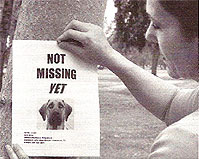
 Vladae The Dog Wizard is a
phenomena in the dog world. He is a former KGB dog-trainer, attributing
his techniques to his deaf-mute mentor.
Vladae The Dog Wizard is a
phenomena in the dog world. He is a former KGB dog-trainer, attributing
his techniques to his deaf-mute mentor.  Glenn
Close is a five-time
Academy Award-nominated American film and stage actress. You've
seen her as Alex (Fatal Attraction) and Cruella di Vil (101 Dalmations).
Glenn
Close is a five-time
Academy Award-nominated American film and stage actress. You've
seen her as Alex (Fatal Attraction) and Cruella di Vil (101 Dalmations).
 Now, you can see her every
week in FX's Damages. Glenn is a dog fanatic and takes
her two dogs to work with her. She shares her celebrity blog
with Animal
Radio®
Now, you can see her every
week in FX's Damages. Glenn is a dog fanatic and takes
her two dogs to work with her. She shares her celebrity blog
with Animal
Radio® Cats and dogs are being banned
in Saudi Arabia and Iran. Religious police authorities, who are
normally tasked with chiding women to cover themselves and ensuring
men attend mosque prayers, are turning to a new target: cats
and dogs.
Cats and dogs are being banned
in Saudi Arabia and Iran. Religious police authorities, who are
normally tasked with chiding women to cover themselves and ensuring
men attend mosque prayers, are turning to a new target: cats
and dogs.
 Jane Alexander is riding high
on the release of "Feast of Love," in theaters
now. She plays Esther Stevenson opposite Greg Kinnear. She is
also Honorary Co-Chair for the 2008 Indianapolis Prize; awarded
to an individual who has accomplished a significant achievement
or achievements in the conservation of an animal species or group
of species, resulting in an advance in long-term survivability
and sustainability.
Jane Alexander is riding high
on the release of "Feast of Love," in theaters
now. She plays Esther Stevenson opposite Greg Kinnear. She is
also Honorary Co-Chair for the 2008 Indianapolis Prize; awarded
to an individual who has accomplished a significant achievement
or achievements in the conservation of an animal species or group
of species, resulting in an advance in long-term survivability
and sustainability. Twelve million dollars will buy
a lot of Milk-Bone. That's the value of a pet trust fund set
up by the late Leona Helmsley to provide for Trouble, her fluffy,
white Maltese, according to court documents made public in New
York.
Twelve million dollars will buy
a lot of Milk-Bone. That's the value of a pet trust fund set
up by the late Leona Helmsley to provide for Trouble, her fluffy,
white Maltese, according to court documents made public in New
York. Many dog owners claim that their
pets anticipate their return, typically by going to wait at a
door, window, driveway, or even at a bus stop (Sheldrake, 1994).
In the early 1990's, Dr. Rupert Sheldrake, a biologist, and former
Fellow of Clare College, Cambridge University, completed a number
of survey studies to find out how many pet owners had observed
seemingly psychic abilities in their pets. Sheldrake's household
surveys found that 46% of dog owners had noticed this ability
in England and 45% in California.
Many dog owners claim that their
pets anticipate their return, typically by going to wait at a
door, window, driveway, or even at a bus stop (Sheldrake, 1994).
In the early 1990's, Dr. Rupert Sheldrake, a biologist, and former
Fellow of Clare College, Cambridge University, completed a number
of survey studies to find out how many pet owners had observed
seemingly psychic abilities in their pets. Sheldrake's household
surveys found that 46% of dog owners had noticed this ability
in England and 45% in California. Why is it that children are bitten
the most? It is estimated that there are over 5 million dogs
bites a year, with most of the victims being children. According
to Vladae, a dog sees a child as a puppy. And when that puppy
doesn't respect the older dog - it bites them as a way of correction,
as it would with their own offspring.
Why is it that children are bitten
the most? It is estimated that there are over 5 million dogs
bites a year, with most of the victims being children. According
to Vladae, a dog sees a child as a puppy. And when that puppy
doesn't respect the older dog - it bites them as a way of correction,
as it would with their own offspring. No matter what your answer--birds,
dogs, cats, and other creatures are invading businesses, churches,
and other religious centers as pet blessings and other ceremonies
are sweeping the nation--the trend has escalated dramatically.
Some people are even shocked that such beastly trends are on
the increase.
No matter what your answer--birds,
dogs, cats, and other creatures are invading businesses, churches,
and other religious centers as pet blessings and other ceremonies
are sweeping the nation--the trend has escalated dramatically.
Some people are even shocked that such beastly trends are on
the increase. We
speak with Annemarie Lucas, who is a Supervisory Special Investigator
for Humane Law Enforcement (HLE) at the American Society for
the Prevention of Cruelty to Animals (ASPCA). She has received
training by both the New York City Police Department (NYPD) and
the Federal Bureau of Investigation (FBI). Annemarie is also
the star of Animal Precinct. She tells Animal Radio®
how someone interested in this line of work can get started.
We
speak with Annemarie Lucas, who is a Supervisory Special Investigator
for Humane Law Enforcement (HLE) at the American Society for
the Prevention of Cruelty to Animals (ASPCA). She has received
training by both the New York City Police Department (NYPD) and
the Federal Bureau of Investigation (FBI). Annemarie is also
the star of Animal Precinct. She tells Animal Radio®
how someone interested in this line of work can get started. The
The  Oscar
the cat, who was adopted as a kitten by the Steere House Nursing
and Rehabilitation Center, seems to be able to predict when patients
there are close to death.
Oscar
the cat, who was adopted as a kitten by the Steere House Nursing
and Rehabilitation Center, seems to be able to predict when patients
there are close to death. Aging cats can develop a feline
form of Alzheimer's disease, a new study reveals. Scientists
at the Universities of Edinburgh, St Andrews, Bristol and California
have identified a key protein which can build up in the nerve
cells of a cat's brain and cause mental deterioration.
Aging cats can develop a feline
form of Alzheimer's disease, a new study reveals. Scientists
at the Universities of Edinburgh, St Andrews, Bristol and California
have identified a key protein which can build up in the nerve
cells of a cat's brain and cause mental deterioration. Glenn
Close has had a lengthy career as a versatile actress and
performer. Glenn is remembered for her chilling roles as the
scheming aristocrat Madame de Merteuil in Dangerous Liaisons,
terrorizing puppies as Cruella di Vil in 101 Dalmations
and as the psychotic book editor Alex Forrest in Fatal Attraction.
In her new series, Damages, Glenn brings force and power
as Patty Hewes, a fierce litigator who has a dog killed. Listen
in as Glenn reveals that she is nothing like the characters she
plays, and in fact is a big animal lover!
Glenn
Close has had a lengthy career as a versatile actress and
performer. Glenn is remembered for her chilling roles as the
scheming aristocrat Madame de Merteuil in Dangerous Liaisons,
terrorizing puppies as Cruella di Vil in 101 Dalmations
and as the psychotic book editor Alex Forrest in Fatal Attraction.
In her new series, Damages, Glenn brings force and power
as Patty Hewes, a fierce litigator who has a dog killed. Listen
in as Glenn reveals that she is nothing like the characters she
plays, and in fact is a big animal lover! Comedian,
writer and actress, Jane Lynch 's breakthrough film role
was as Christy Cummings, the masculine-lesbian personal dog handler
to trophy wife Sheri Ann Cabot (Jennifer Coolidge) in the director
Christopher Guest's 2000 mockumentary Best in Show. Jane
is the host of the 2nd Annual "
Comedian,
writer and actress, Jane Lynch 's breakthrough film role
was as Christy Cummings, the masculine-lesbian personal dog handler
to trophy wife Sheri Ann Cabot (Jennifer Coolidge) in the director
Christopher Guest's 2000 mockumentary Best in Show. Jane
is the host of the 2nd Annual " Cesar
Millan, America's most-popular
dog trainer is back for a fourth season of The Dog Whisperer.
Millan has released a new book, "Be the Pack Leader."
Animal
Radio® welcomes him back for his fourth appearance.
Last time, it got intimate. Don't miss him on his favorite radio
show. He gets personal on "breed-bans."
Cesar
Millan, America's most-popular
dog trainer is back for a fourth season of The Dog Whisperer.
Millan has released a new book, "Be the Pack Leader."
Animal
Radio® welcomes him back for his fourth appearance.
Last time, it got intimate. Don't miss him on his favorite radio
show. He gets personal on "breed-bans."  Best-selling author Robert Fulgham's
(Everything I need to know I learned in Kindergarten -
16-million copies) new book begins with a question we've
all asked ourselves: "What on Earth have I done?" Animal Radio® is
proud to have this current-day philosopher as a special guest.
As an ordained minister, he often deals with animal issues, especially
related to grieving and death.
Best-selling author Robert Fulgham's
(Everything I need to know I learned in Kindergarten -
16-million copies) new book begins with a question we've
all asked ourselves: "What on Earth have I done?" Animal Radio® is
proud to have this current-day philosopher as a special guest.
As an ordained minister, he often deals with animal issues, especially
related to grieving and death. Get
ready for spring by protecting your dog and your family
against intestinal worm infections! Did you know that eggs
and larvae that infect dogs can survive in the environment for
months even in extreme winter weather conditions? And that
those same parasites can also infect humans? Why take chances?
Make intestinal deworming an important part of your dog's routine
health care with Safe-Guard® Canine Dewormer a safe
and effective way to eliminate and prevent the major intestinal
worms that can infect dogs all year round. Just sprinkle it on
your dog's food twice a year, for complete peace of mind!
Get
ready for spring by protecting your dog and your family
against intestinal worm infections! Did you know that eggs
and larvae that infect dogs can survive in the environment for
months even in extreme winter weather conditions? And that
those same parasites can also infect humans? Why take chances?
Make intestinal deworming an important part of your dog's routine
health care with Safe-Guard® Canine Dewormer a safe
and effective way to eliminate and prevent the major intestinal
worms that can infect dogs all year round. Just sprinkle it on
your dog's food twice a year, for complete peace of mind! Little
did Debbie Parkhurst know that when she found a dog in a dumpster
2 years ago, that he would save her life.
Little
did Debbie Parkhurst know that when she found a dog in a dumpster
2 years ago, that he would save her life.
 A pet dog caused $50,000 of damage
when it turned on its owner's cooker and burnt down the kitchen.
Skylar, a three-year-old 'goldendoodle', apparently started a
kitchen fire when she tried to jump on the stove to get leftover
pizza. It happened after her owner Fred Haines left his home
in Naperville, Illinois, to go to work, reports the Chicago Sun-Times.
A pet dog caused $50,000 of damage
when it turned on its owner's cooker and burnt down the kitchen.
Skylar, a three-year-old 'goldendoodle', apparently started a
kitchen fire when she tried to jump on the stove to get leftover
pizza. It happened after her owner Fred Haines left his home
in Naperville, Illinois, to go to work, reports the Chicago Sun-Times. DOES
YOUR DOG HAVE GINGIVITIS OR ACHY JOINTS?
DOES
YOUR DOG HAVE GINGIVITIS OR ACHY JOINTS? From
springtime through the late fall, many people are subject to
seasonal allergies. But people are not the only ones suffering.
For our dogs and cats, these same seasons can bring intense itching
and discomfort. Yes, it seems our pets can get their own "hay
fever".
From
springtime through the late fall, many people are subject to
seasonal allergies. But people are not the only ones suffering.
For our dogs and cats, these same seasons can bring intense itching
and discomfort. Yes, it seems our pets can get their own "hay
fever". Did
you know that Urine Off is the #1 Vet recommended Urine Odor
and Stain Remover. In fact, for the last 3 years THOUSANDS of
Vets nationwide have recommended Urine Off to their clients,
solving their #1 Household problem, unsightly urine odors and
stains. Urine Off's professional strength formula is designed
to remove odors and stains even old ones, by getting down
to the source of the problem and removing it permanently. Endorsed
by many of the leading animal organizations, and sworn on by
our thousands of loyal customers, who after using it always say
the same thing: "Thanks Urine Off, finally something that
works."
Did
you know that Urine Off is the #1 Vet recommended Urine Odor
and Stain Remover. In fact, for the last 3 years THOUSANDS of
Vets nationwide have recommended Urine Off to their clients,
solving their #1 Household problem, unsightly urine odors and
stains. Urine Off's professional strength formula is designed
to remove odors and stains even old ones, by getting down
to the source of the problem and removing it permanently. Endorsed
by many of the leading animal organizations, and sworn on by
our thousands of loyal customers, who after using it always say
the same thing: "Thanks Urine Off, finally something that
works." 
 Who would you choose as the most
popular wizard of all time? Gandalf? Obi-Wan? The Wizard of Oz?
Harry? How about the Master of all Wizards - Merlin.
Who would you choose as the most
popular wizard of all time? Gandalf? Obi-Wan? The Wizard of Oz?
Harry? How about the Master of all Wizards - Merlin. It's
becoming that time of year again, holiday season is upon us and
the first fun date to kick us off is Halloween. Though the night
can be filled with fun and foolishness, safety for all in your
family is first and foremost. Below you will find Pets911.com's
8 Halloween must do's and don'ts for your furry friends. Make
this Halloween a safe and joyful one for you and your animals!!
It's
becoming that time of year again, holiday season is upon us and
the first fun date to kick us off is Halloween. Though the night
can be filled with fun and foolishness, safety for all in your
family is first and foremost. Below you will find Pets911.com's
8 Halloween must do's and don'ts for your furry friends. Make
this Halloween a safe and joyful one for you and your animals!! Make
sure your pet isn't near an open flame or fireplace;
Make
sure your pet isn't near an open flame or fireplace;

 NETWORK PROGRAMS:
NETWORK PROGRAMS:
 PET STORES, VETS, GROOMERS:
Would you like to broadcast Animal Radio Network in your store
or office? Call 435.644.5992 to get set up. Animal Radio Network
is simulcast throughout America to your store.
PET STORES, VETS, GROOMERS:
Would you like to broadcast Animal Radio Network in your store
or office? Call 435.644.5992 to get set up. Animal Radio Network
is simulcast throughout America to your store. Over
the year of reading these articles for Animal Radio®, you
probably have noticed that my friends and I live life differently
than most. Our day-to-day decisions are based on what is mutually
acceptable for our animal kids and ourselves. We appreciate the
input we receive from our animal kids and do our best to fulfill
their wishes.
Over
the year of reading these articles for Animal Radio®, you
probably have noticed that my friends and I live life differently
than most. Our day-to-day decisions are based on what is mutually
acceptable for our animal kids and ourselves. We appreciate the
input we receive from our animal kids and do our best to fulfill
their wishes.
 Email
your events to:
Email
your events to:  2ND
ANNUAL "RACE FOR THE RESCUES"
2ND
ANNUAL "RACE FOR THE RESCUES" October 12 & 13
October 12 & 13 Sunday, October 27, 2007
Sunday, October 27, 2007 Second Annual Walk-A-Pet For Life
dog Walk
Second Annual Walk-A-Pet For Life
dog Walk
 Earth conscious consumers now have an eco-friendly
choice in pet care. The Natural line of products by Simple Solution
is completely, 100% all-natural. The Biodegradable Training Pads,
used by many pet owners as an indoor potty, are 100% biodegradable
even by California's standards. They'll biodegrade faster than
an orange peel! The line also offers an all natural Pet Stain
and Odor Remover that's a great alternative to harsh chemicals
found in traditional household cleaners. Simple Solution®
Natural Pet Bathing Shampoo cleans and conditions with all natural
ingredients including, plant-based mild cleansers, Aloe Vera,
Vitamin E and Pro Vitamin B-5. Simple Solution Natural is based
on a way of life! Find Simple Solution at Petco, PetSmart or
your local pet retailer.
Earth conscious consumers now have an eco-friendly
choice in pet care. The Natural line of products by Simple Solution
is completely, 100% all-natural. The Biodegradable Training Pads,
used by many pet owners as an indoor potty, are 100% biodegradable
even by California's standards. They'll biodegrade faster than
an orange peel! The line also offers an all natural Pet Stain
and Odor Remover that's a great alternative to harsh chemicals
found in traditional household cleaners. Simple Solution®
Natural Pet Bathing Shampoo cleans and conditions with all natural
ingredients including, plant-based mild cleansers, Aloe Vera,
Vitamin E and Pro Vitamin B-5. Simple Solution Natural is based
on a way of life! Find Simple Solution at Petco, PetSmart or
your local pet retailer.  Poop-Freeze
Poop-Freeze Deluxe
Fresh Flow Pet Fountain from Petmate
Deluxe
Fresh Flow Pet Fountain from Petmate
 Fido
Friendly magazine lists accommodations where you can stay with
your dog while traveling in the United States and Canada. Each
quarter, our editorial includes hotel, city and state reviews.
Fido
Friendly magazine lists accommodations where you can stay with
your dog while traveling in the United States and Canada. Each
quarter, our editorial includes hotel, city and state reviews.
 How
often do hawks need to eat? I know that they eat a variety of
prey, but some prey is larger than others. Is a single mouse
going to keep a hawk satisfied for an entire day or will it need
to continue hunting? And what if, instead of a mouse, the hawk
catches a squirrel? Will that keep it full for an entire day
or maybe two? If a meal is large enough, can a hawk go more than
a day without hunting?- Ann, Wakefield, MA
How
often do hawks need to eat? I know that they eat a variety of
prey, but some prey is larger than others. Is a single mouse
going to keep a hawk satisfied for an entire day or will it need
to continue hunting? And what if, instead of a mouse, the hawk
catches a squirrel? Will that keep it full for an entire day
or maybe two? If a meal is large enough, can a hawk go more than
a day without hunting?- Ann, Wakefield, MA For
small birds, with their high metabolism, resting time is short.
Their tiny bodies don't allow them room to store much food and
they must get back to eating fairly quickly. This is good news
for people who enjoy watching birds at their feeder and even
better news for people like me who sell birdseed. And yes, Ann,
I know you asked about hawks. I promise I'll get to that next.
But since nobody has asked about feeding birds for a while I
wanted to slip that in. I have mortgage payments, you know.
For
small birds, with their high metabolism, resting time is short.
Their tiny bodies don't allow them room to store much food and
they must get back to eating fairly quickly. This is good news
for people who enjoy watching birds at their feeder and even
better news for people like me who sell birdseed. And yes, Ann,
I know you asked about hawks. I promise I'll get to that next.
But since nobody has asked about feeding birds for a while I
wanted to slip that in. I have mortgage payments, you know.
 Humans may have invented gobs of gadgets
to communicate better with one another (think cell phones, email,
and text messaging), but we still haven't figured out how to
talk to the animals, or have we?
Humans may have invented gobs of gadgets
to communicate better with one another (think cell phones, email,
and text messaging), but we still haven't figured out how to
talk to the animals, or have we? Koko's intelligence and her ability
to express empathy and deep emotion have forever changed our
perception of gorillas and how we relate to them. Who can forget
the touching images of Koko cuddling her first kitten, "All
Ball" in the January 1985 issue of "National Geographic"
magazine? Not long after the photos were published, All Ball
was tragically killed by a car and Koko's wrenching sobs and
her distraught sign, "Koko Sad," still haunt us today.
Koko's intelligence and her ability
to express empathy and deep emotion have forever changed our
perception of gorillas and how we relate to them. Who can forget
the touching images of Koko cuddling her first kitten, "All
Ball" in the January 1985 issue of "National Geographic"
magazine? Not long after the photos were published, All Ball
was tragically killed by a car and Koko's wrenching sobs and
her distraught sign, "Koko Sad," still haunt us today. I have a 5 month old kitten named
Ninja. We love Ninja to pieces, but she has one annoying habit
that we're worried about. Ninja bites hard when we play with
her. I admit we probably play a little rough with her. Since
we've gotten her, she's loved being rolled on her back and tickled.
We've noticed that as she gets older her bites are getting more
painful, to the point of almost breaking our skins. The other
annoying habit she's recently developed is that she sometimes
attacks our feet at night while we are sleeping.
I have a 5 month old kitten named
Ninja. We love Ninja to pieces, but she has one annoying habit
that we're worried about. Ninja bites hard when we play with
her. I admit we probably play a little rough with her. Since
we've gotten her, she's loved being rolled on her back and tickled.
We've noticed that as she gets older her bites are getting more
painful, to the point of almost breaking our skins. The other
annoying habit she's recently developed is that she sometimes
attacks our feet at night while we are sleeping. We
received an e-mail from Animal Radio® host Hal Abrams recently.
Short but to the point. Hal was pretty upset! The email also
had a link to a news story that Hal thought we should be doing.
We
received an e-mail from Animal Radio® host Hal Abrams recently.
Short but to the point. Hal was pretty upset! The email also
had a link to a news story that Hal thought we should be doing. But
you may think like Hal (and a number of Aussies too we should
add!!) that "this is a pretty cruel thing to do to
a sentient being!" but the little Fox is considered a highly
dangerous pest down here!
But
you may think like Hal (and a number of Aussies too we should
add!!) that "this is a pretty cruel thing to do to
a sentient being!" but the little Fox is considered a highly
dangerous pest down here! DOGGIE
SUDZ™ is Austin Rose Inc.'s new Organic pet shampoo/conditioner.
Botanical extracts, including Aloe Vera, Vitamin E and Neem Oil,
clean and soften your pets' coat to a shiny luster. Soothes insect
bites and repels insects naturally. DOGGIE SUDZ™ is gentle
enough for everyday use! Vegan certified, it has NO Alcohol,
Pesticides, Phosphates, Detergents, Dyes, SLS, DEA or TEA. DOGGIE
SUDZ™ is available in 16 fl oz bottles in MANGO and LAVENDER
scents and includes a FREE pet charm in each bottle, while supplies
last! 1-800-945-0190
DOGGIE
SUDZ™ is Austin Rose Inc.'s new Organic pet shampoo/conditioner.
Botanical extracts, including Aloe Vera, Vitamin E and Neem Oil,
clean and soften your pets' coat to a shiny luster. Soothes insect
bites and repels insects naturally. DOGGIE SUDZ™ is gentle
enough for everyday use! Vegan certified, it has NO Alcohol,
Pesticides, Phosphates, Detergents, Dyes, SLS, DEA or TEA. DOGGIE
SUDZ™ is available in 16 fl oz bottles in MANGO and LAVENDER
scents and includes a FREE pet charm in each bottle, while supplies
last! 1-800-945-0190


 FINAL POOP
FINAL POOP
 *
ADVERTISING OPPORTUNITIES for 2007 ANIMAL RADIO®
PROGRAMMING available. Call 435.644.5992. Animal Radio® Network, according to Arbitron radio
ratings, is the most-listened-to animal programming in the United
States. We have 250,000 Average-Quarter-Hour listeners - which
translates to an audience of two-million weekly in ninety-plus
cities. Our affiliate stations are top performers including KOST
103.5 and KBIG 104.3 in Los Angeles. Animal Radio® is the most concentrated radio audience
of targeted animal lovers anywhere! Please contact us for aggressive
and omnipotent branding and cultivating customer loyalty. Advertising
opportunities in this newsletter are also available. 38,000 subscribers
are reading this message right now!
*
ADVERTISING OPPORTUNITIES for 2007 ANIMAL RADIO®
PROGRAMMING available. Call 435.644.5992. Animal Radio® Network, according to Arbitron radio
ratings, is the most-listened-to animal programming in the United
States. We have 250,000 Average-Quarter-Hour listeners - which
translates to an audience of two-million weekly in ninety-plus
cities. Our affiliate stations are top performers including KOST
103.5 and KBIG 104.3 in Los Angeles. Animal Radio® is the most concentrated radio audience
of targeted animal lovers anywhere! Please contact us for aggressive
and omnipotent branding and cultivating customer loyalty. Advertising
opportunities in this newsletter are also available. 38,000 subscribers
are reading this message right now! *
If you're a RADIO PROGRAMMER and would like to air ANIMAL
RADIO® - call 435-644-5992 to get all the information
you need to begin broadcasting America's number one animal talk
show geared to listeners that like to have FUN! Animal Radio® programming is FREE for your station
- and delivered via Satellite (Jones and ABC/NY Starguide) or
Compact Disc or MP3 every week.
*
If you're a RADIO PROGRAMMER and would like to air ANIMAL
RADIO® - call 435-644-5992 to get all the information
you need to begin broadcasting America's number one animal talk
show geared to listeners that like to have FUN! Animal Radio® programming is FREE for your station
- and delivered via Satellite (Jones and ABC/NY Starguide) or
Compact Disc or MP3 every week.